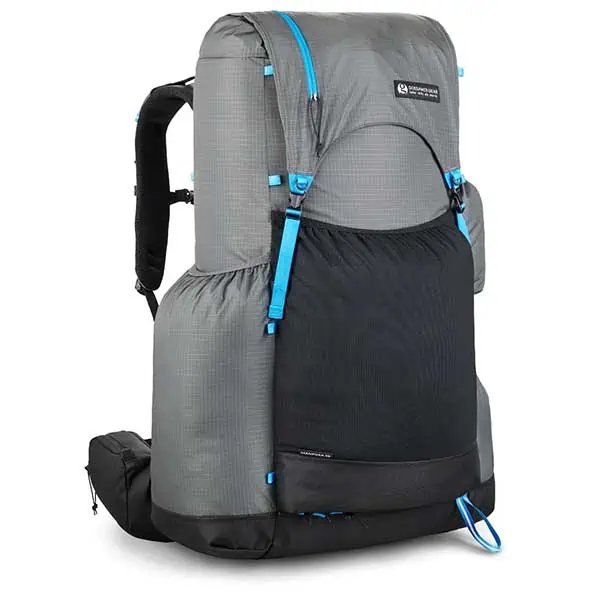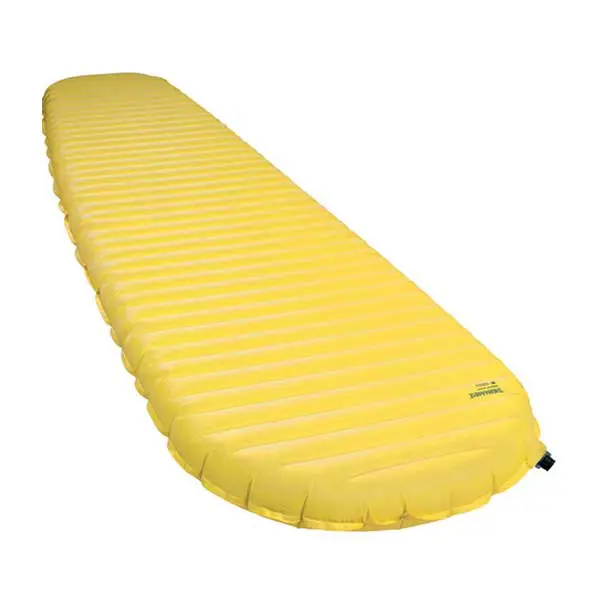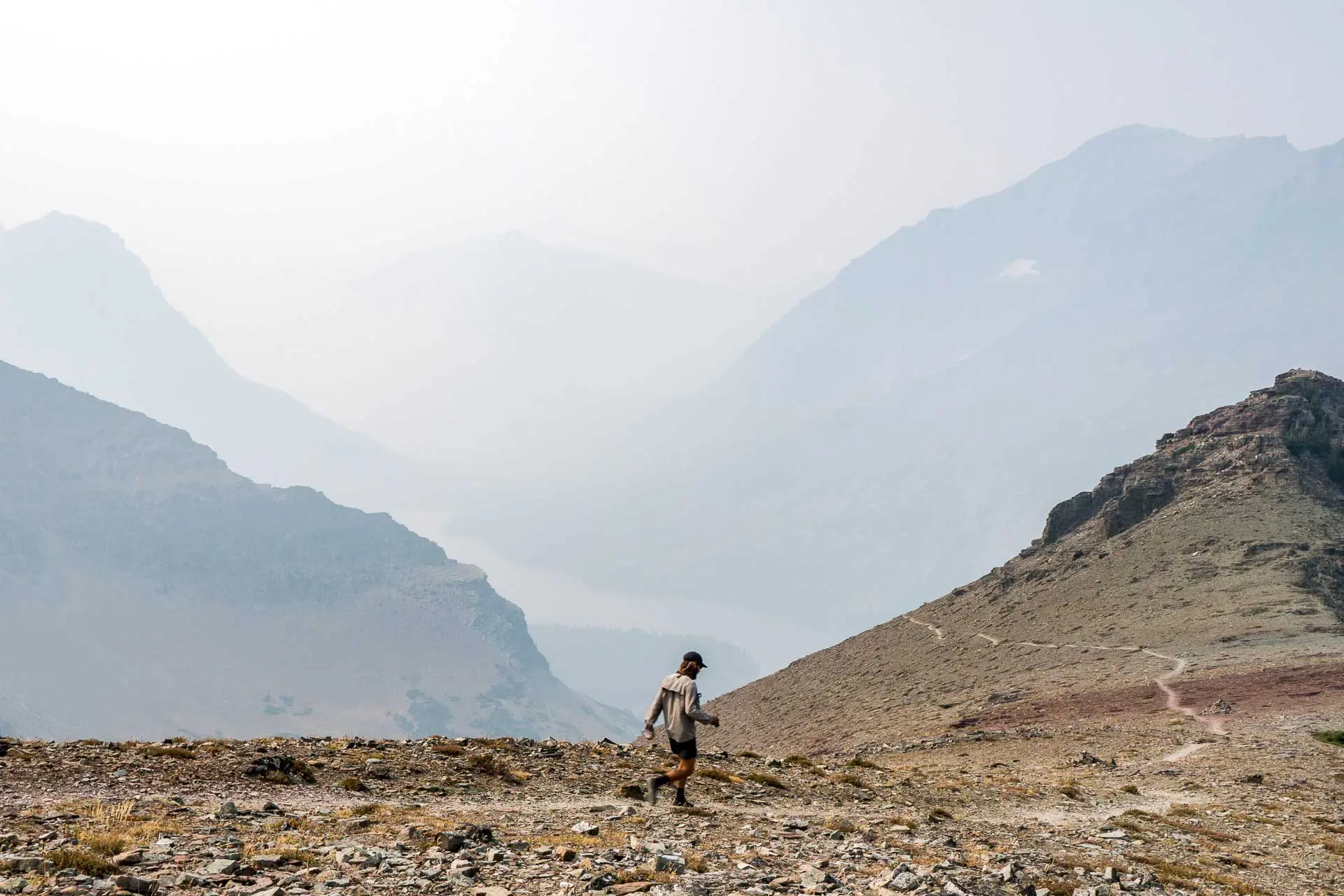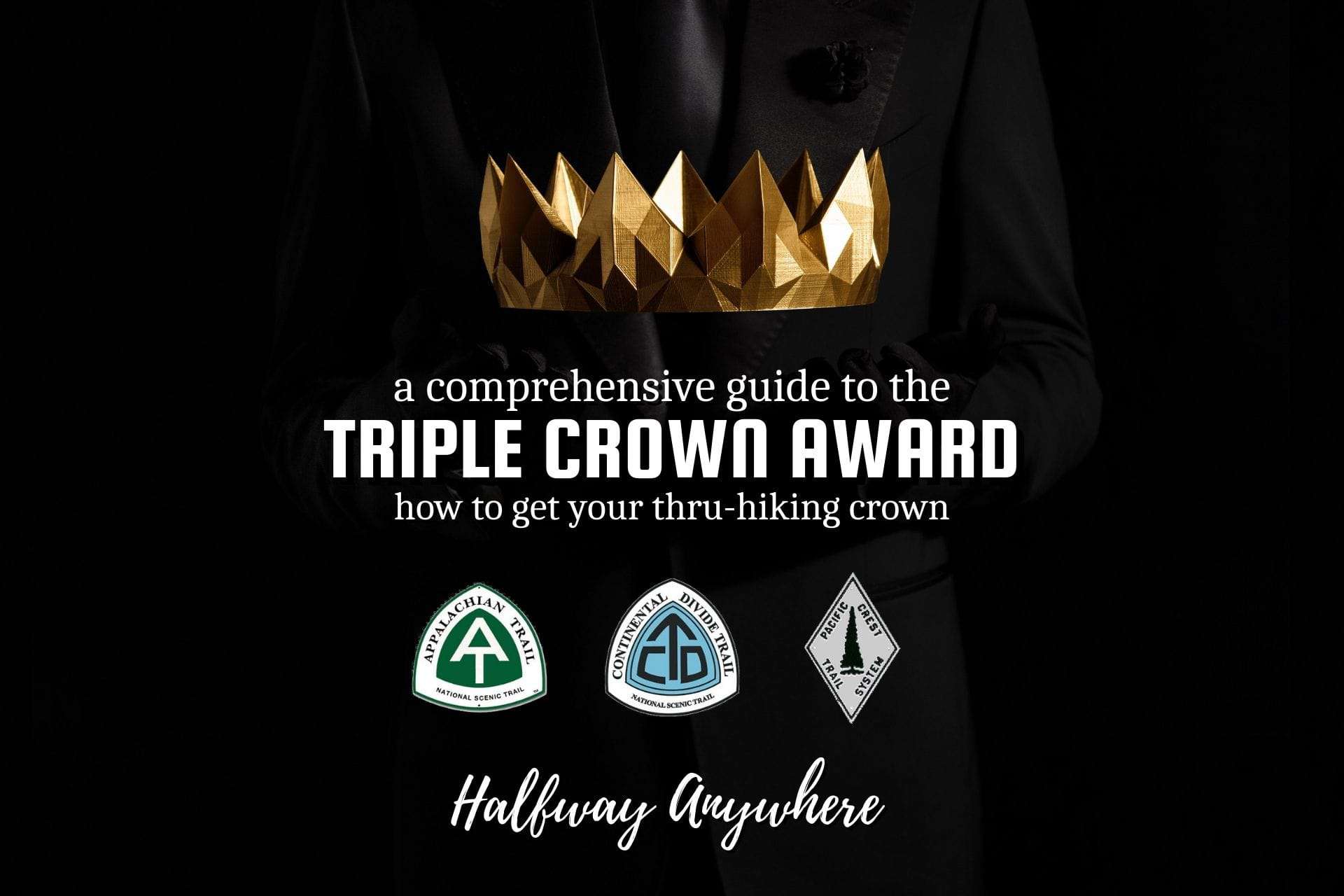Continental Divide Trail Hiker Survey (2024)
The Continental Divide Trail Hiker Survey is distributed to CDT hikers at the end of the hiking season every year to capture a snapshot of the year’s class and provide a helpful resource to future CDT hikers and recreators. The Survey is now in its eighth year, and I would like to thank everyone who took the time to participate and provide feedback.
This year’s survey is the most comprehensive yet, and I’ve devoted a tremendous amount of time to compiling the results. Again, the CDT Survey is meant to be a useful resource to help anyone interested in hiking the Continental Divide Trail figure out how to approach the seemingly monstrous journey. Every year, I try to improve the data collected and fine-tune the presentation to best help hikers. I would love to hear what you think.
Congratulations on arriving at a spot in the CDT Survey that most readers have probably skipped. There’s a lot to cover (I’ll probably need to split this initial article into multiple posts in the future), so I won’t waste your time with any more filler. Here are Halfway Anywhere’s 2024 Continental Divide Trail Hiker Survey results!
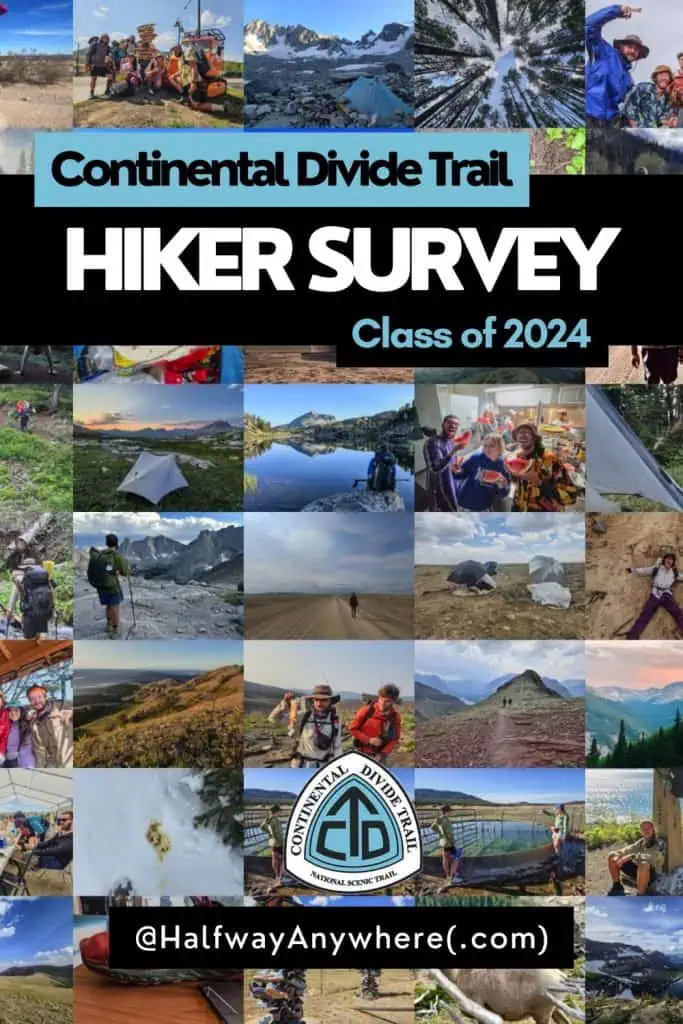
Notes on the Data
- This year, there were 213 completed surveys. Hiking next year? Sign up to take the survey here.
- Some responses are sorted and colored – e.g., northbound or southbound. More on this below.
- The Continental Divide Trail and thru-hiking generally use acronyms and jargon. If anything is unclear, the thru-hiker glossary may help. Please comment if you still can’t find what you’re looking for.
- I ask that respondents do their best to respond accurately. Not every hiker answers every question, and not every answer is guaranteed 100% accurate (e.g., someone may mistakenly report taking 15 nearo days instead of 17).
- I refer to survey respondents collectively as this year’s “class.” Remember, this is a sample.
- These results invoke basic statistics. To maximize your time here, familiarize yourself with average, median (M), and standard deviation (σ).
- For stats requiring the length of the CDT for a calculation (e.g., mileage/day), I use 2,974.5 mi / 4,787 km (from the FarOut Guides CDT app).
- More detailed posts focused on CDT Gear, CDT Resupply, CDT Horror Stories, and CDT Advice in the coming weeks. If you would like to be notified of new surveys, click here.
Data Labels
- Thru-Hikers
- Northbound Thru-Hikers
- Southbound Thru-Hikers
- The number (1) is appended when using data from hikers who completed the trail.
- The number (0) is appended when using data from hikers who did not complete the trail.
If no label has been appended, I used all collected data (i.e., it includes section hiker data).
Unless otherwise noted, I use the following colors to differentiate each section of the Continental Divide Trail. These colors are typically used in the graphs below.
- New Mexico, Colorado, Wyoming, Idaho/Southern Montana, Northern Montana
Demographics
First, we look at information from the Continental Divide Trail Class of 2024 that won’t help anyone plan a thru-hike, but that’s interesting nonetheless. We’ll look at CDT hiker gender, age, race, education, sexual orientation, marital status, children, where hikers are from, and employment (including how hikers could take time off to hike the CDT).
CDT Hiker Gender
- 66.0% – Male
- 32.5% – Female
- 1% – Non-Binary
- 0.5% – Trans Man
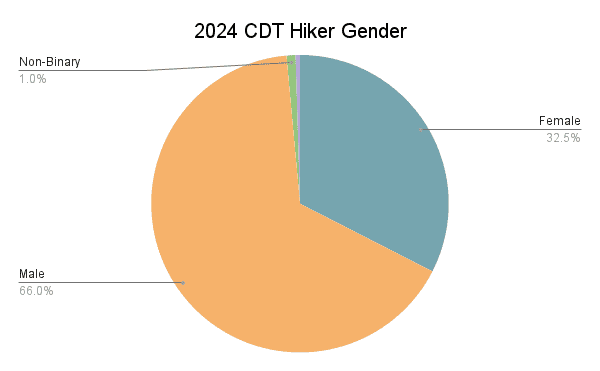
CDT Hiker Age
- 0.0% – < 20
- 6.9% – 20-24
- 19.2% – 25-29
- 23.2% – 30-34
- 12.8% – 35-39
- 15.8% – 40-49
- 10.3% – 50-59
- 9.4% – 60-70
- 2.5% – 70+
Average age: 39
Median age: 35
σ: 13
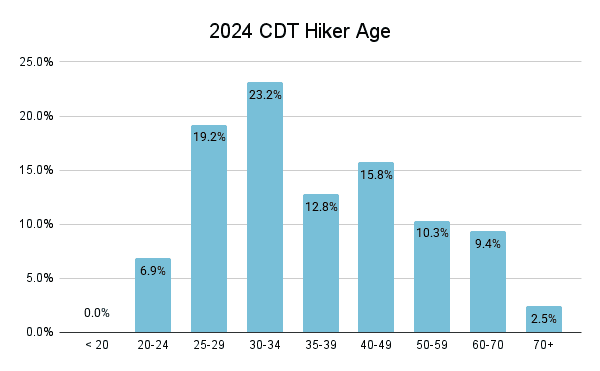
CDT Hiker Race
- 96.5% – White
- 2.3% – Two or More Races
- 1.2% – Hispanic or Latino
- 0.6% – Black or African American
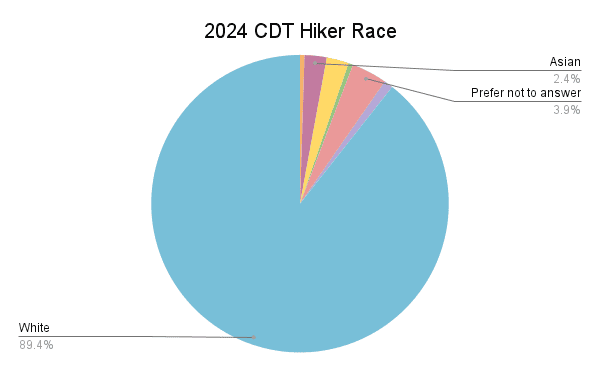
CDT Hiker Education
- 43.2% – Bachelor’s degree
- 27.7% – Master’s Degree
- 7.8% – Some college, no degree
- 4.9% – Associate degree
- 3.4% – Graduated high school or equivalent
- 2.4% – MBA
- 2.4% – MD
- 1.9% – JD
- 1.9% – PhD
- 3.4% – Trade school
- 0.5% – ABD
- 0.5% – Prefer not to answer
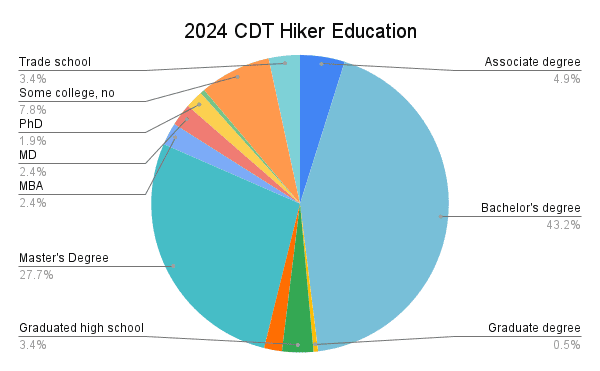
CDT Hiker Sexual Orientation
- 80.7% – Heterosexual (straight)
- 5.3% – Bisexual
- 2.9% – Pansexual
- 1.9% – Asexual
- 1.9% – Gay
- 1.4% – Queer
- 0.5% – Lesbian
- 5.3% – Prefer not to answer
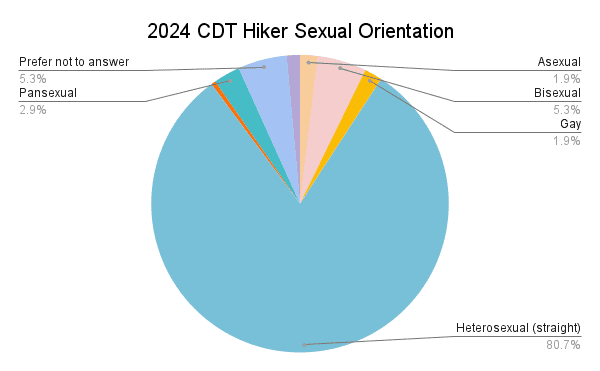
CDT Hiker Marital Status
- 46.1% – Single, never married
- 23.3% – Married or domestic partnership
- 20.4% – In a committed relationship
- 6.8% – Divorced
- 1.0% – Widowed
- 0.5% – In an open relationship
- 1.9% – Prefer not to answer
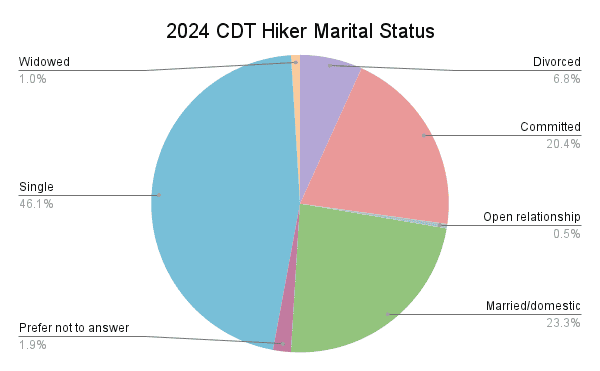
CDT Hiker Children
- 3.4% – One child
- 8.3% – Two children
- 2.9% – Three children
- 1.9% – Four children
- 1.0% – Five children
- 0.0% – Over five children
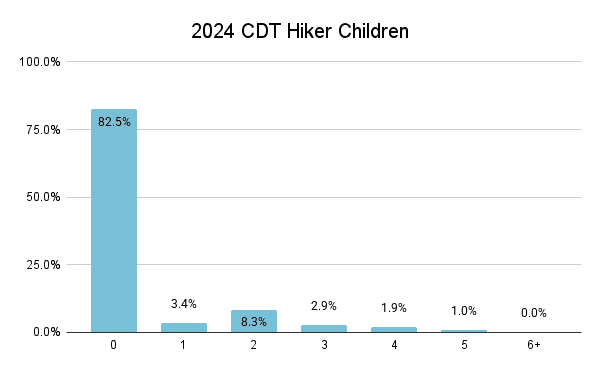
Where Hikers Are From
With thru-hiking’s growing popularity, the Continental Divide Trail attracts people from across the United States and the world. Here’s where hikers on the trail this year hailed from.
- Countries: Australia, Belgium, Canada, Croatia, Cuba, Czechia, Denmark, Finland, France, Germany, Hong Kong, Lithuania, Netherlands, New Zealand, Russia, Slovakia, Sweden, Switzerland, United Kingdom, United States (20 total)
- States: Alabama, Arizona, California, Colorado, Florida, Georgia, Idaho, Illinois, Kentucky, Louisiana, Maine, Maryland, Massachusetts, Michigan, Minnesota, Missouri, Montana, Nevada, New Jersey, New Mexico, New York, North Carolina, Ohio, Oregon, Pennsylvania, Rhode Island, South Carolina, South Dakota, Tennessee, Texas, Utah, Vermont, Virginia, Washington, Wisconsin, Wyoming (36 total)
Worldwide CDT hiker distribution
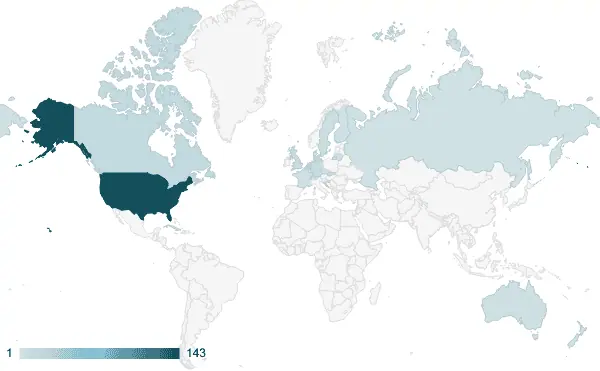
CDT hiker distribution across the United States
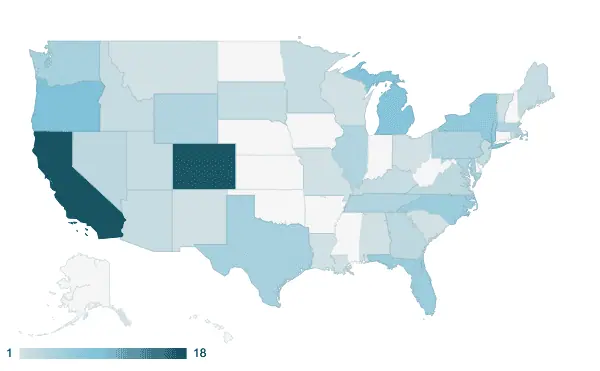
The Most-Represented Countries
- USA 66.5%
- Germany 6.5%
- Canada 4.7%
- France, United Kingdon 4.1%
- Australia 2.9%
The Most-Represented States
- California 12.9%
- Colorado 12.1%
- Oregon 6.4%
- Michigan 5.7%
- New York 5.0%
Hiker Jobs & Working Conditions
How can you take so much time off to hike for five months across the United States? Probably a question most would-be Continental Divide Trail hikers have been asked. I ask hikers what they do for work (when they’re not incredible hiking machines) and how they can take time off to hike the CDT.
CDT Hiker Jobs
This year, hikers reported 83 different professions. The most common of which were:
- 9.0% – Seasonal Work
- 5.5% – Software Engineer
- 3.5% – Construction
- 3.5% – IT
- 3.5% – Registered Nurse
- 3.0% – Project Manager
- 2.5% – Doctor
- 4.5% – Educator
- 2.5% – Government
- 1.5% – Accountant
10.6% (larger than any profession) reported being retired, and 1.5% were students. More on this in the next section.
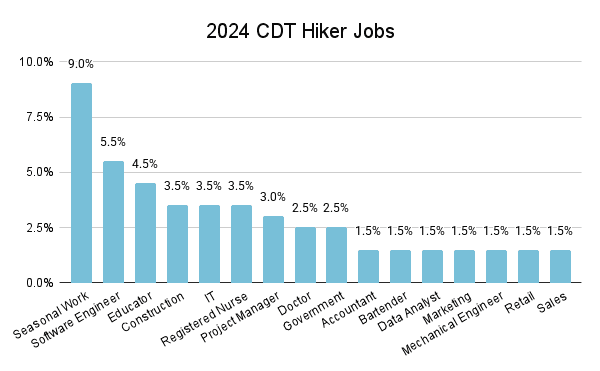
CDT Hiker Working Conditions
How were this year’s thru-hikers able to take the time to hike the CDT?
- 33.6% – Quit job
- 11.2% – Unpaid time off
- 11.9% – Flexible work conditions
- 7.7% – Between jobs
- 7.0% – Sabbatical
- 6.3% – Seasonal worker
- 4.9% – Self-employed
- 4.9% – Unemployed
- 3.5% – Gap year
- 3.5% – Paid time off
- 2.8% – Retirement
- 1.4% – Negotiated into employment
- 1.4% – Student
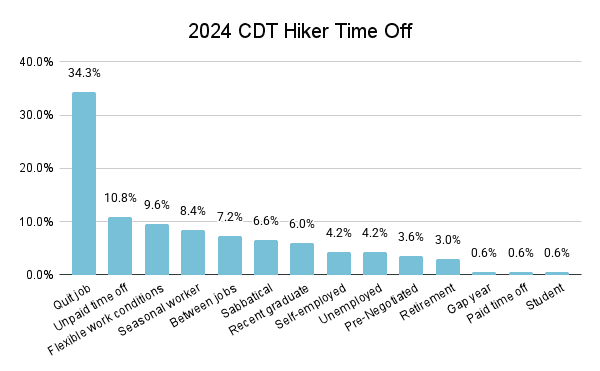
Hiker Experience
Here’s a look at what the 2024 class looked like during their “Planning a CDT Hike” phase. This section examines time spent planning, first-time hikers, hiker experience level, and other trails hiked.
Time Spent Planning
I ask thru-hikers how much time they spend planning for their thru-hikers on a scale of 0 (no time at all) to 10 (every waking moment). I will drill down in a future post on whether this impacted hikes.
- 0 – 4.3%
- 1 – 8.6%
- 2 – 10.3%
- 3 – 17.8%
- 4 – 15.7%
- 5 – 14.6%
- 6 – 11.4%
- 7 – 6.5%
- 8 – 7.0%
- 9 – 1.6%
- 10 – 2.2%
Average: 4.2
Median: 4
σ: 2.3
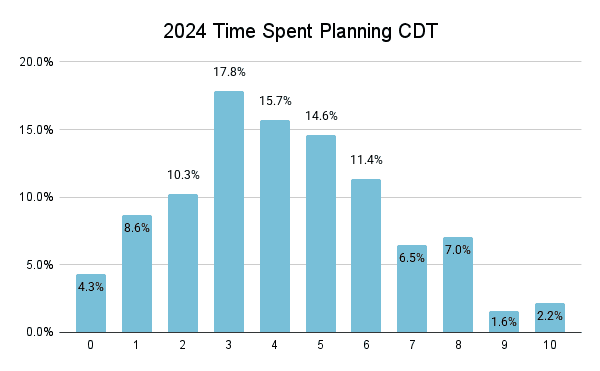
CDT Hiker Experience Level
Instead of asking thru-hikers whether this would be/was their first long-distance hike, I ask the distance of thru-hikers longest hike to date (pre-CDT) – more on the specifics of this below.
I use 100 mi / 160 km as the cutoff for a long-distance hike (sorry, Wonderland Trail hikers).
First Time Thru-Hikers
- 7.1% – First long-distance hike
- 92.9% – Not first long-distance hike
Average longest trail hiked: 2,044 mi / 3,290 km
Median: 2,600 mi / 4,184 km
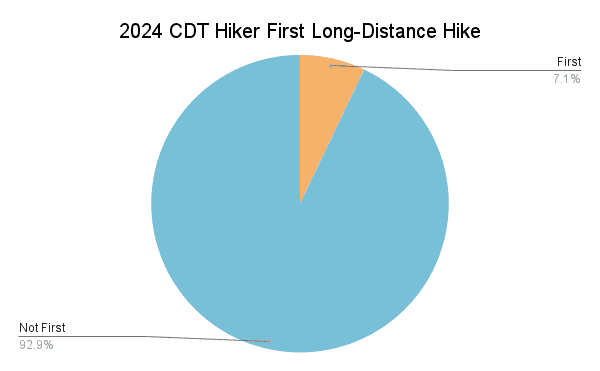
CDT Hiker Experience
In addition to asking about the longest trail completed by thru-hikers pre-CDT, I ask thru-hikers to evaluate their backpacking experience on a scale of 1 to 10.
- Average experience: 8.8
- Median experience: 10
- σ: 2.1
Thru-Hikers (1): 8.8 | σ = 2.1 | M = 10
Thru-Hikers (0): 8.4 | σ = 2.1 | M = 10

Previous Trails Hiked
The trails most commonly hiked by those with experience were:
- 52.2% – Pacific Crest Trail
- 47.4% – Appalachian Trail
- 19.1% – Colorado Trail
- 13.1% – Arizona Trail
- 13.1% – Long Trail
- 12.0% – PCT Section Hike
- 11.6% – John Muir Trail
- 9.6% – Te Araroa Trail
- 8.8% – CDT Section Hike
- 8.0% – AT Section Hike
- 8.0% – Tahoe Rim Trail
- 6.8% – Continental Divide Trail (previous year)
- 6.0% – Tour du Mont Blanc
- 5.2% – GR20
- 23.1% – Other
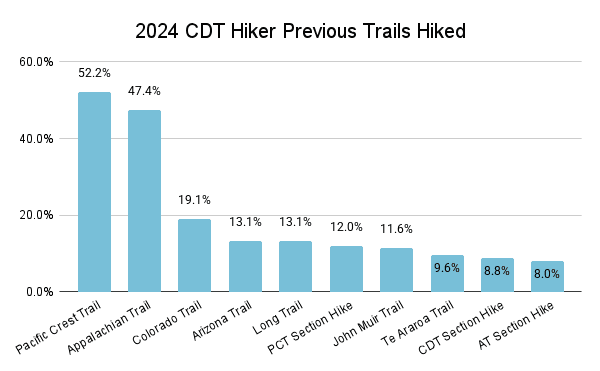
Note: these percentages are for the hikers who have already completed a long-distance hike, not the entire class.
Pre-Hike Training
Next, we’ll examine whether thru-hikers trained in preparation for their thru-hikes, what they did (if anything) to train, and how thru-hikers rated their fitness (pre-CDT).
CDT Hiker Training
- 64.9% – Trained
- 35.1% – Didn’t Train
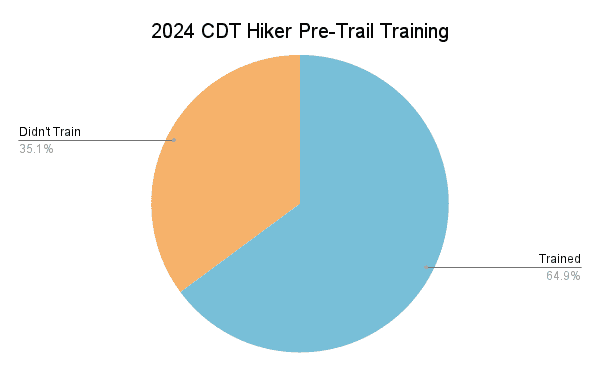
How Hikers Trained
- Day hikes – 40.5%
- Walking – 31.9%
- Running – 27.0%
- Weight training – 23.8%
- Multi-day hikes – 20.5%
- Mobility exercises – 20.0%
- Stretching – 18.4%
- Yoga – 15.1%
- Incline walking – 10.3%
- Bicycling – 9.7%
- Step machine – 8.1%
- Physical therapy – 7.6%
- Backcountry Tours – 5.9%
- Stairs – 5.9%
- Other – 25.9%
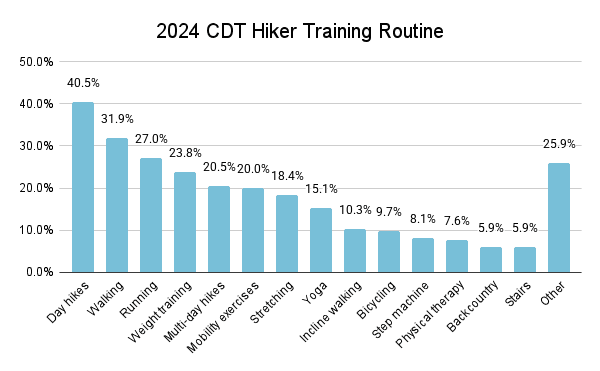
Pre-Trail Fitness Level
I asked thru-hikers to rate their fitness level (on a scale of 1 to 10) before beginning the trail.
- 0.5% – 1
- 1.1% – 2
- 4.9% – 3
- 8.7% – 4
- 17.4% – 5
- 20.7% – 6
- 21.2% – 7
- 20.1% – 8
- 3.8% – 9
- 1.6% – 10
Average fitness: 6.2
Median fitness: 6
σ: 1.7
Thru-Hikers (1): 6.2 | σ = 1.7 | M = 6
Thru-Hikers (0): 6.2 | σ = 1.7 | M = 6
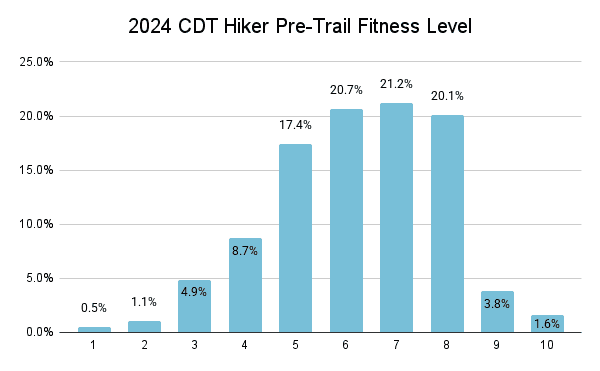
Money Spent on Hike
How much does it cost to hike the Continental Divide Trail? This a question on the minds of many thru-hikers before starting their hikes. The safe answer? More than you think. Hopefully, the aggregate data from this year’s class will paint a more accurate picture.
Thru-Hikers (1)
$8,882
The average amount spent on the entirety of a thru-hike
M = $8,000 | σ = $4,759
Thru-Hikers (1)
$64
The average amount spent per day on a thru-hike
M = $60 | σ = $33
Thru-Hikers
$1,139
The average amount spent on gear before starting
M = $1,000 | σ = $988
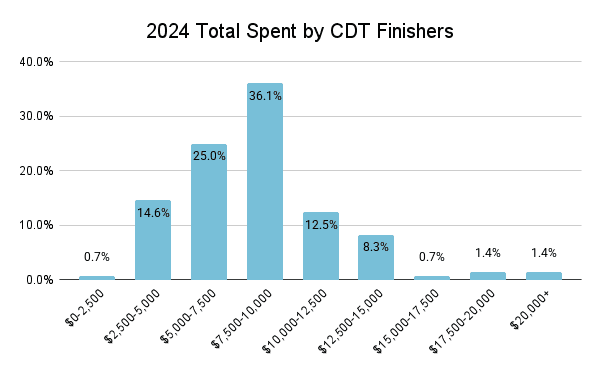
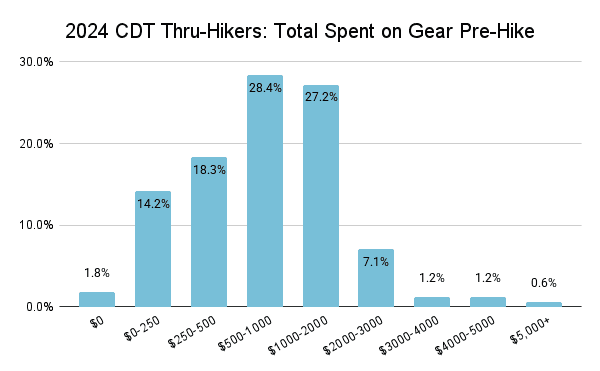
Thru-Hikers (1)
$8,461
Average spent by domestic thru-hikers
M = $8,000 | σ = $3,252
Thru-Hikers (1)
$9,723
Average spent by international thru-hikers
M = $8,250 | σ = $7,027
I asked Continental Divide Trail hikers if they encountered surprise expenses while hiking the CDT.
Even if you purchase and test all your gear beforehand and pre-package all your resupplies (I strongly recommend against this resupply strategy), you can’t predict what will happen during a CDT thru-hike.
As part of this breakdown, I also ask thru-hikers how much they spend on gear during their thru-hikes – this could be either repairing, replacing, or supplementing gear.
Surprise Expenses
- 52.3% Yes
- 47.7% No
Unexpected expenses fell into three categories: gear replacement, hotel stays, and travel along the trail.
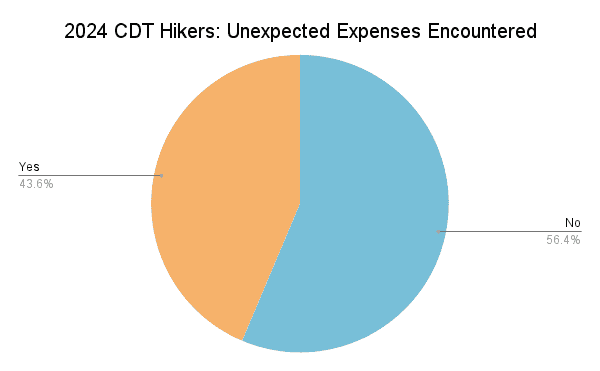
Surprise Expense Encountered
- 30.4% – Hotel stays
- 24.9% – Replacing/upgrading gear
- 23.2% – Cost of food in town
- 18.8% – Buying new gear
- 18.8% – Travel/Transportaion
- 2.2% – Other
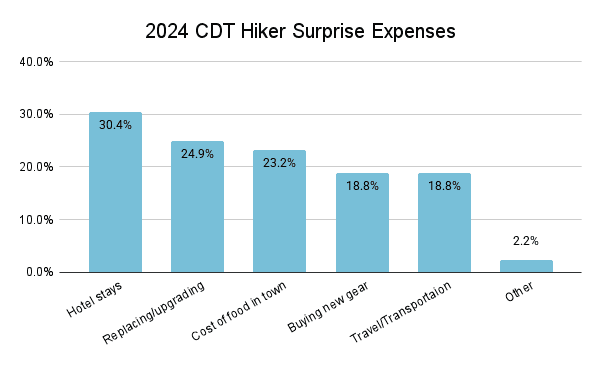
Note: These percentages are for all hikers, not just those with an unforeseen expense.
Hiking Partners, Camping, & Alone Time
Beginning a thru-hike on your own can sound scary and intimidating, but every year, most thru-hikers (and hikers in general) start their hikes alone.
Here, we’ll look at who hikers began with, how much time they spent hiking and camping alone (and cowboy camping), whether they stayed with their hiking partner(s), hiking group sizes, and hiker relationships.
CDT Hiker Starting Company
- 54.3% – Started alone
- 20.7% – Started with partner
- 17.6% – Started with friend(s)
- 4.3% – Started with family
- 3.2% – Started with stranger(s)
Of this year’s first-time thru-hikers, 38.5% began their hikes alone (the data above/in the graph is for all hikers).

Time Hiking Alone
- 8.0% – 0%
- 10.3% – 1-10%
- 3.8% – 11-20%
- 5.2% – 21-30%
- 3.3% – 31-40%
- 8.0% – 41-50%
- 3.3% – 51-60%
- 4.7% – 61-70%
- 16.0% – 71-80%
- 15.5% – 81-90%
- 20.2% – 91-99%
- 1.9% – 100%
σ = 35 | M = 75
59.2% – Average time thru-hikers spent hiking alone
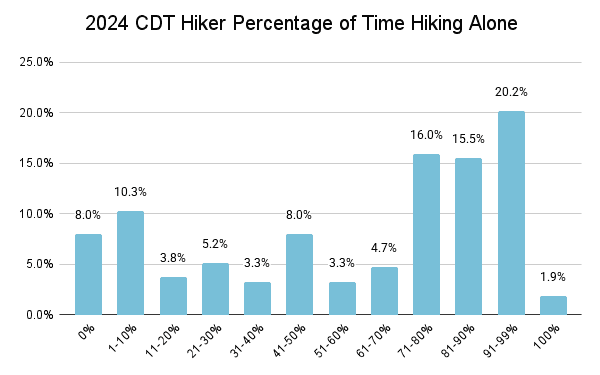
“Hiking alone” measures how long hikers weren’t physically walking with someone down the trail. It does not necessarily imply they weren’t hiking with others throughout the day (i.e., camping with others).
Nights Camped Alone
- 21.1% – 0%
- 19.2% – 1-10%
- 4.2% – 11-20%
- 6.6% – 21-30%
- 5.6% – 31-40%
- 6.6% – 41-50%
- 2.8% – 51-60%
- 6.1% – 61-70%
- 5.2% – 71-80%
- 11.7% – 81-90%
- 8.5% – 91-99%
- 2.3% – 100%
σ = 37.3 | M = 30
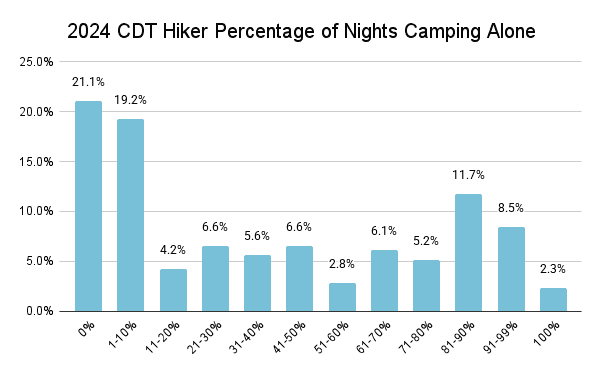
36.7% was the average percentage of nights thru-hikers spent camping alone (σ = 36.7 | M = 25). When we look at thru-hikers (1), this translates to an average of 39 nights spent camping alone.
Nights Cowboy Camping
- 31.9% – 0%
- 40.4% – 1-10%
- 10.8% – 11-20%
- 2.8% – 21-30%
- 3.3% – 31-40%
- 2.3% – 41-50%
- 3.8% – 51-60%
- 2.3% – 61-70%
- 1.9% – 71-80%
- 0.0% – 81-90%
- 0.5% – 91-99%
- 0.0% – 100%
σ = 20.5 | M = 2
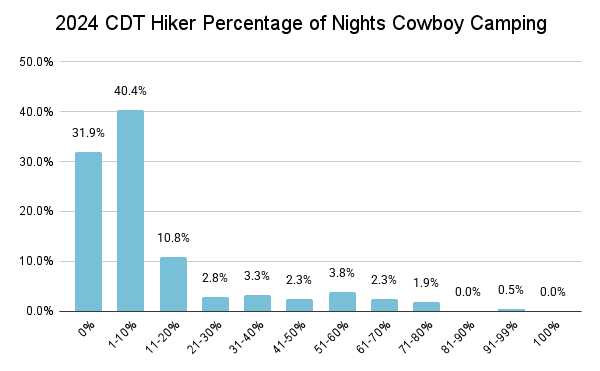
12.9% was the average percentage of nights thru-hikers spent cowboy camping (σ = 20.5 | M = 3). When we look at thru-hikers (1), this translates to an average of 14 nights of cowboy camping.
Hiking Partner(s)
Beginning a hike with someone is one thing, but remaining together and finishing it with someone is arguably as impressive as the trail itself. Here’s how things worked out for those who began their hikes with another person.
Remaining with Partner(s)
- 52.8% – Stayed with partner
- 19.1% – Mostly stayed together
- 14.6% – Partner got off
- 6.7% – Wasn’t the plan
- 2.2% – I got off
- 2.2% – Wasn’t for best
- 2.2% – No longer friends
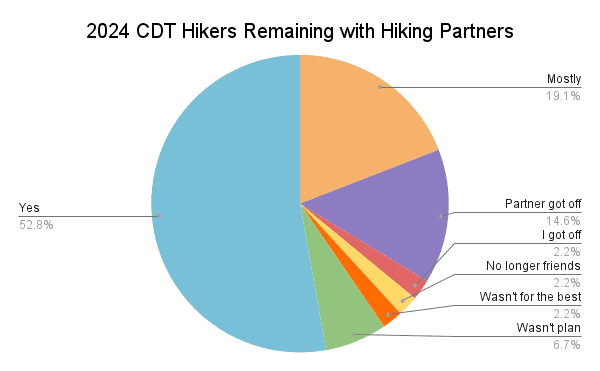
Size of Hiking Groups
Despite most hikers beginning their Continental Divide Trail hikes alone, most hikers will link up and hike with at least one other person for a considerable amount of their time on the CDT. Some hikers refer to this as a trail family or “tramily“. Here are the largest groups hikers found themselves hiking with regularly.
Average group size: 3.6
Median size: 3
σ: 2.7
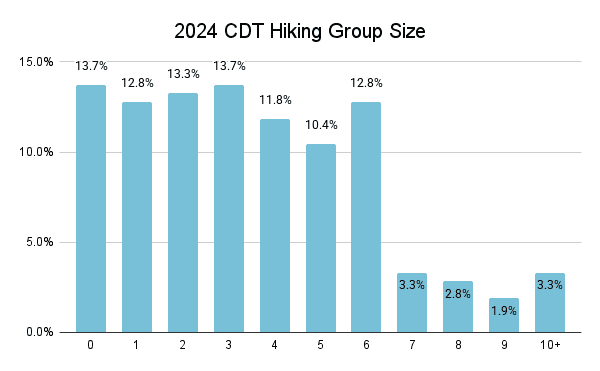
Relationship Status
I ask thru-hikers, “At the start of the CDT, were you in a relationship?”
- 47.6% – No, and I am still single
- 45.5% – Yes, and I am still with the same person
- 3.2% – No, but now I am in a relationship with someone I met on the CDT
- 2.7% – Yes, but I am now single
- 0.5% – No, but now I am in a relationship with someone I met before the CDT
- 0.5% – Yes, but now I am in a relationship with someone I met on the CDT
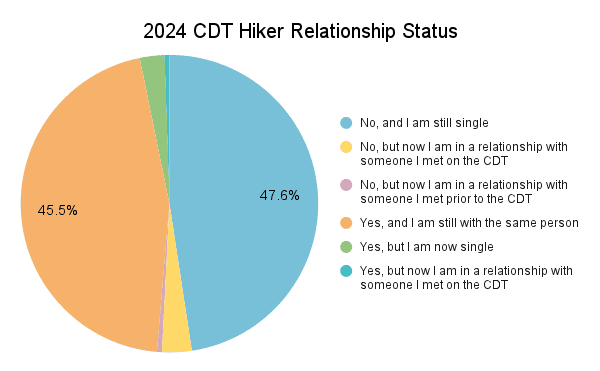
Starting Dates & Locations
Unlike the Pacific Crest Trail, the Continental Divide Trail does not have a permit; hikers are issued for the entirety of the trail (not yet, at least). Instead, hikers can begin the CDT on any date at the southern or northern terminus.
However, a permit is required to camp in Glacier National Park (i.e., from the northern terminus south), Yellowstone National Park, and Rocky Mountain National Park.
Northbound vs. Southbound CDT Hikers
Which direction to hike the Continental Divide Trail seems to be a bit more divisive than the Pacific Crest Trail. Because the San Juan Mountains in Southern Colorado can hold a lot of snow until late in the year, many hikers opt to hike southbound. That said, hikes must then (potentially) contend with higher snow levels in Northern Montana or Wyoming’s Wind River Range.
Regardless of the direction, CDT thru-hikes decide to hike; there’s a good chance they’ll be contending with snow at some point – unless they flip-flop.
According to the data, here’s what the northbound/southbound hiker divide looked like.
- 56.6% – Northbound
- 43.4% – Southbound

Northbound CDT Hikers
Since getting to what’s generally considered to be the official southern terminus at Crazy Cook isn’t easy, the Continental Divide Trail Coalition (CDTC) operates a (paid) shuttle service. In recent years, a few private individuals have also started independent (for-profit) shuttle operations.
This section will cover when northbound thru-hikers began, and how they got to the southern terminus.
Northbound CDT Starting Dates
Northbound
April 20
Average start date
M = April 21
Northbound
May 1
Average start date of hikers who said they would like to have started earlier
Northbound
April 20
Average start date of hikers who said they would like to have started later
How Northbound Hikers Reached Crazy Cook
- 92.7% – CDTC Shuttle
- 4.2% – Private Transport
- 1.0% – Trail Angel
- 1.0% – Hiked
- 1.0% – Paid Transport
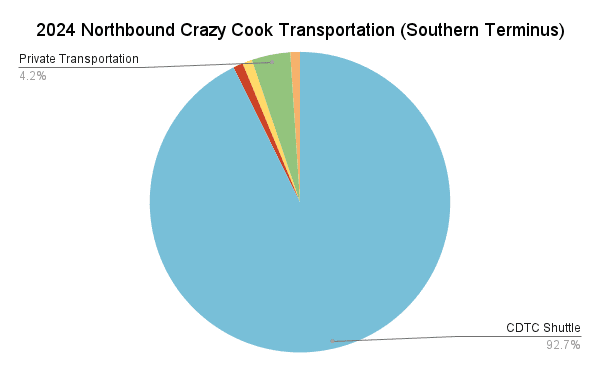
Southbound CDT Hikers
There are a couple of northern terminus options for southbound CDT hikers, although the Chief Mountain starting location appears to be becoming the default.
This section covers where southbound CDT hikers began, when they began, and how they got back from the southern terminus (those that completed the trail).
Southbound Start Location
- 92.3% – Chief Mountain
- 7.7% – Waterton
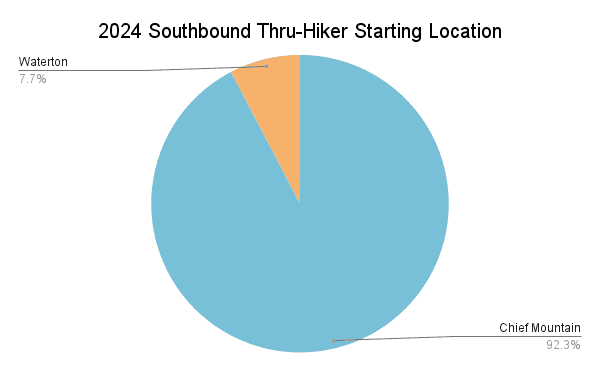
Southbound
June 20
Average starting date
M = June 20
Southbound
June 26
Average starting date of hikers who said they would like to have started earlier
Southbound
June 18
Average starting date of hikers who said they would like to have started later
How Hikers Returned from Crazy Cook
Crazy Cook, the southern terminus of the CDT, is not easy to get to. Here’s how southbound hikers returned to Lordsburg, New Mexico (or beyond) after reaching the terminus.
- 35.7% – Trail Angel
- 24.3% – Crazy Cook Shuttle
- 15.7% – Private Transportation
- 12.9% – Hiked
- 5.7% – CDTC Shuttle
- 5.7% – Tim Sharp
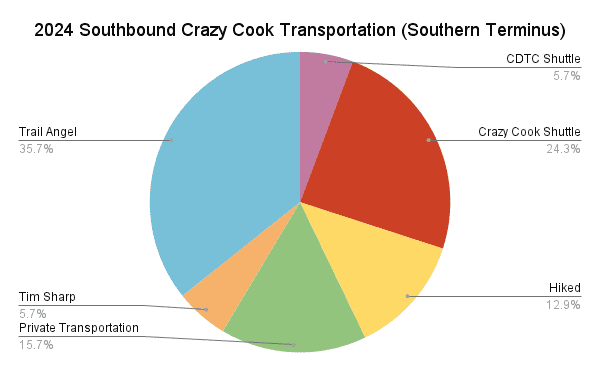
Hiking Stats & Dates
The Continental Divide Trail has five sections: New Mexico, Colorado, Wyoming, Idaho/Southern Montana, and Northern Montana. Because the CDT can get a bit crazy regarding alternates (especially the Anaconda Route or Big Sky/Super Butte Cutoff), I’ve divided the following data by section.
In this section, we look at how long thru-hikers took for each section of the trail, a breakdown of hike lengths and averages, and how many days hikers took off (zero/nearo days).
Northbound Hike Breakdown
The average number of days it took hikers to complete:
- 40 – New Mexico
- 41 – Colorado
- 27 – Wyoming
- 41 – Idaho+Montana
- 146 – Average days for northbound (1) to complete the CDT.
Southbound Hike Breakdown
The average number of days it took hikers to complete:
- 46 – Idaho+Montana
- 27 – Wyoming
- 35 – Colorado
- 31 – New Mexico
- 133 – Average days for southbound (1) to complete the CDT.
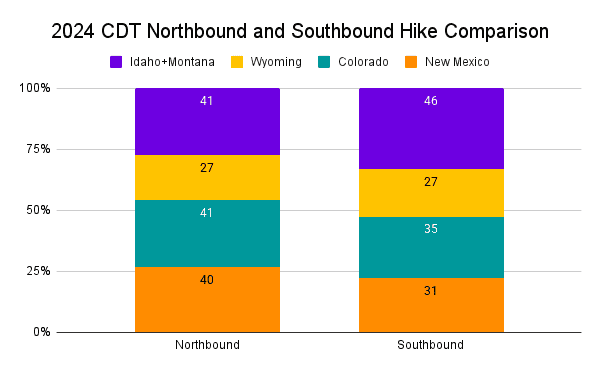
Length of Thru-hikes
Thru-Hikers (1)
140
The average number of days of an entire thru-hike
(M = 141 | σ = 19.1)
Thru-Hikers (1)
125
The average number of days hiking (total minus zero days)
(M = 123 | σ = 16.6)
Northbound (1)
10/5
The average finish date (5/10 for the rest of the world)
(M = September 30)
Thru-Hikers (1)
22.3 mi
The average daily mileage (35.9 km)
(M = 21.6 mi / 34.8 km | σ = 3.4 mi / 5.5 km)
Thru-Hikers (1)
25.1 mi
The average daily mileage after removing zero days (40.4 km)
(M = 24.8 mi / 39.9 km | σ = 3.4 mi / 5.5 km)
Thru-Hikers (1)
40.1 mi
The average longest day of hiking (64.5 km)
(M = 36 mi / 57.9 km | σ = 11.3 mi / 18.2 km)
Zero and Nearo Days (i.e., Days Off)
Thru-Hikers (1)
16
The average number of zero days (days off from hiking)
(M = 14 | σ = 9)
Thru-Hikers (1)
14
The average number of nearo days (low mileage days)
(M = 14 | σ = 9)
Thru-Hikers (1)
5
The average longest consecutive number of zero days
(M = 4 | σ = 5)
Finishing Location
As some of you may have already deduced, since there are multiple locations at the Mexican and Canadian borders where Continental Divide Trail hikers begin their hikes, there are an equal number of locations where CDT hikers can finish.
This section looks at where northbound hikers finished, where southbound hikers finished, and what percentage of hikers completed their hikes (in either direction).
Northbound Finish Location
- 80.2% – Waterton Lake
- 16.0% – Chief Mountain
- 3.7% – Elsewhere
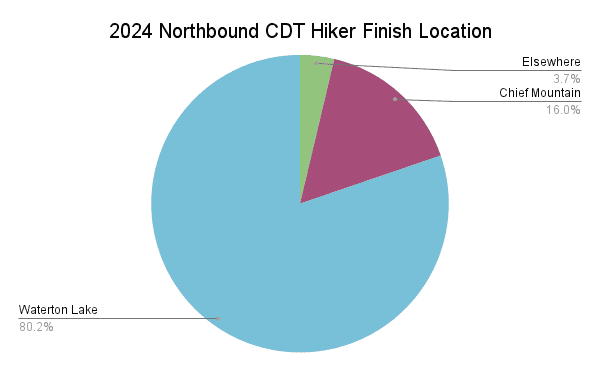
All southbound thru-hikers reported finishing their hikes at Crazy Cook Monument at the New Mexico-Mexico Border south of Lordsburg, except one hiker who flipped to Colorado (yes, this is the same as last year).
CDT Completion Rates
Most people begin a Continental Divide Trail thru-hike intending to complete the trail. Unfortunately, not everyone who sets out on this most epic adventure of border-to-border glory completes the trail. Every year, many people hoping to hike the CDT will fail to complete the trail.
We will look at completion rates, but we are doing so with a caveat. I distribute this survey myself; it is not required of CDT hikers. Therefore, survey respondents are a self-selecting group who skew toward having completed the trail.
A hopeful thru-hiker who quit during their first week of hiking in April is likely paying little attention and caring far less about the Continental Divide Trail survey when it’s released in the fall. So, if you’re reading this and planning to hike the CDT next year, sign up for the survey to ensure you receive it!
Thru-Hikers
86%
The percentage of thru-hiker respondents who completed the CDT.
Northbound
82%
The percentage of northbound thru-hiker respondents who completed the CDT.
Southbound
92%
The percentage of southbound thru-hiker respondents who completed the CDT.
Flip-Flopping & Footpaths
Flip-flopping is when a hiker skips a section of the trail (the flip), intending to return to hike it later (the flop). This can happen because a hiker wants to avoid snow, skip a fire closure, or because of some other logistical issue. The flip-flop usually takes one of two forms.
One is a hiker skipping ahead, continuing to hike in the same direction, and then returning to the point they originally departed the trail to hike the skipped section later (e.g., a northbound hiker skips from the NM/CO border to the CO/WY border, then hikes north to Canada before returning to the NM/CO border to hike north to the CO/WY border).
It can also be when a hiker skips ahead and then hikes the skipped section in the opposite direction of their original hike before jumping back up to the point where they initially skipped to and continuing their hike in the original direction (e.g., northbound hiker jumps from NM/CO border to CO/WY border and then hikes south to NM/CO border before returning to CO/WY border to continue walking north).
Some hikers get wild with their flip-flopping; I recommend avoiding it altogether, if possible.
Here is what flip-flopping on the CDT looked like in 2024.
Did Hikers Flip-Flop
Thru-Hikers 14% Yes
Thru-Hikers 86% No
Northbound 20% Yes
Northbound 80% No
Southbound 8% Yes
Southbound 92% No
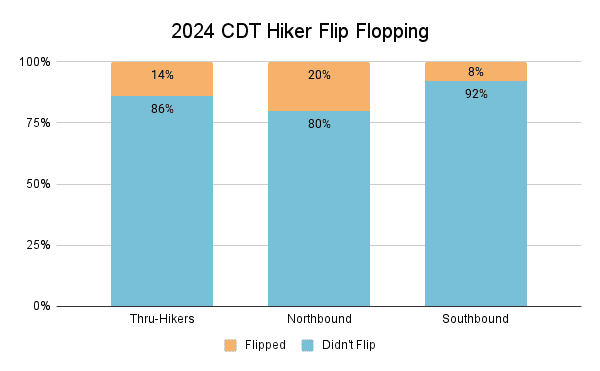
Why Hikers Flip-Flopped
- 69.2% – Snow
- 15.4% – Personal/Logistical
- 2.4% – Injury
- 2.4% – Fires
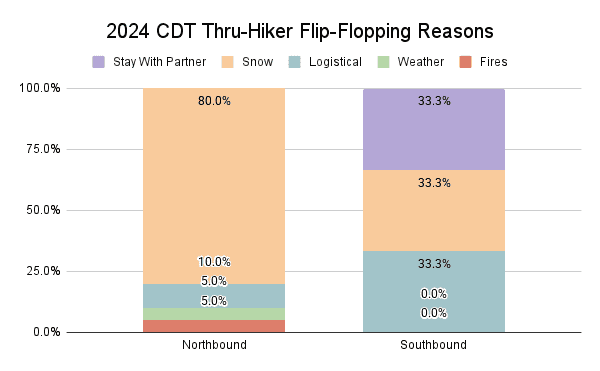
Where Hikers Flipped From/To
I’ve struggled in the past to display this information in a way I think will be helpful and accurately represent the CDT flip-flopping picture, but I think this is an improvement upon previous years. Please let me know if you have any suggestions.
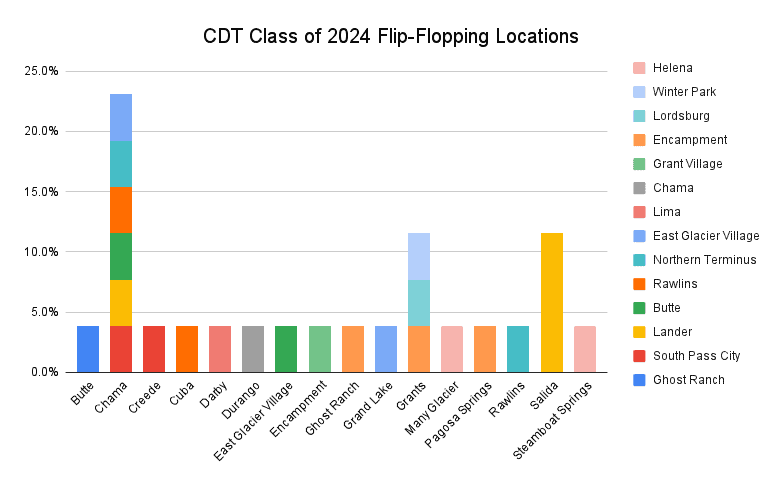
Continuous Footpaths
It may sound straightforward enough, “Did you complete the CDT? Yes or no?” But what constitutes a completed thru-hike isn’t necessarily the same for everyone.
Some people insist you need to have unbroken steps between Mexico and Canada along the official Continental Divide Trail to constitute a thru-hike. In contrast, others may forgive skipping a road walk, hitchhiking around a fire closure, or taking alternates (or shortcuts).
To better understand how much of the trail this year’s finishers hiked, I asked about their footsteps between the terminuses.
- 40.3% – Skipped some small sections
- 24.2% – Mostly, but may have missed a bit
- 22.6% – Yes, connected footsteps
- 22.6% – Yes, and walked around fire closures
- 10.5% – Skipped some large sections
- 2.4% – Yes, and walked through fire closures
- 1.6% – Yes, but skipped fire closures
Do not hike through fire closures. Yes, thru-hiking is awesome; no, thru-hiking doesn’t make you special. Hiking through fire closures puts you, crews, and SAR at risk. Don’t be an idiot. Nobody cares if you’re hiking the CDT; closures are part of the reality of the trail.

Alternate Routes
The Continental Divide Trail is more well-defined than many suspect, but there are loads of alternate trails (sometimes known as “shortcuts”) that hikers can take instead of or in addition to the official CDT. I ask about these alternates to understand what the most common CDT thru-hikes looked like. Alternates are listed in geographical order from south to north.
The following colors indicate the popularity of each alternate (the percentage of hikers who took each): over 75%, 50-75%, 25-50%, and under 25%.
New Mexico Alternates
- Columbus Alternate: 0.6%
- Columbus Gila Alternate: 0.6%
- Gila River Alternate: 90.1%
- Gila River High Route Alternate: 45.3%
- Govina Canyon Alternate 26.1%
- Walnut Creek Alternate: 21.7%
- Pie Town Alternate via Mangas Mountain: 63.4%
- Cebolla Wilderness Alternate: 41.6%
- Bonita-Zuni Alternate: 36.6%
- Mount Taylor Alternate: 47.8%
- Ghost Ranch Alternate: 71.4%
- Christmas Alternate: 8.1%
Colorado Alternates
- Great Divide Alternate: 12.3%
- Elwood Pass 8.4%
- Creede Cutoff: 28.4%
- Mirror Lake Alternate: 9%
- Collegiate East: 16.8%
- Twin Lakes Cutoff: 39.4%
- Mount Elbert: 25.8%
- Silverthorne Alternate: 21.9%
- Montezuma Alternate: 9%
- Argentine Spine: 31%
- Rocky Mountain National Park Shortcut: 56.1%
Wyoming Alternates
- Ley Alternate south of Rawlins: 24.9%
- Wind River High Route (Dixon): 9.7%
- Wind River High Route (Skurka): 5.6%
- Cirque of the Towers: 78.6%
- Knapsack Col: 47.7%
- Leeds Creek: 12.6%
- Old CDT (near Dubois): 34.8%
- Gros Ventre: 16.7%
- Teton Crest Trail: 22%
Idaho/Montana Alternates
- Mack’s Inn Alternate: 39.9%
- Big Sky/Super Butte Cutoff: 23.8%
- Anaconda Cutoff: 53.5%
- Butte Connector: 3.5%
- Chinese Wall High Route: 5.2%
- Spotted Bear Pass: 57.6%
- Ptarmigan Tunnel: 9.9%
- Chief Mountain: 48.3%
- Waterton to Chief Mountain: 1.7%
“Ley Alternate” refers to an alternate route on the Ley Maps – maps produced by CDT hiker Jonathan Ley. More on the Ley Maps here.
Hiker Challenges
I asked hikers which sections of the CDT they found the most difficult and which they found the easiest. Next year, I plan on expanding this question to get a more specific idea of where hikers find the trail to be most and least challenging.
I’ve also asked hikers how well, on a scale of 1 to 10, they coped with challenges on the trail, such as storms, fires, mosquitoes, and stream crossings.
Easiest CDT Section
- 69.1% – New Mexico
- 5.6% – Colorado
- 11.7% – Wyoming
- 6.8% – Idaho/Southern Montana
- 6.8% – Northern Montana
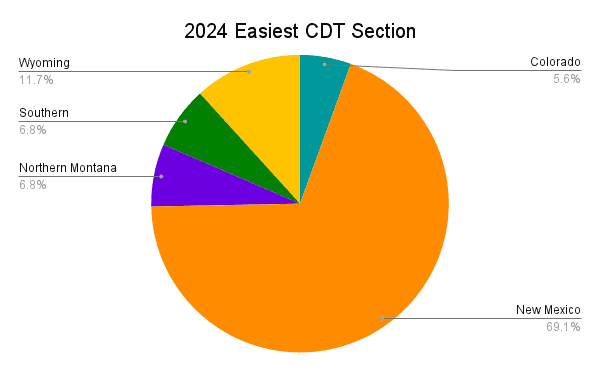
Most Difficult CDT Section
- 5.6% – New Mexico
- 79% – Colorado
- 6.8% – Wyoming
- 6.2% – Idaho/Southern Montana
- 2.5% – Northern Montana
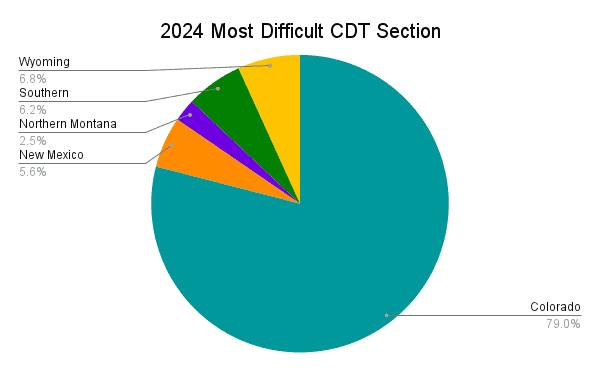
On-Trail Issues
On a scale of 1 to 10, I asked hikers how much of an issue each of the following was during their hikes. Here are the averages from thru-hikers (1).
- 4.10 – Storms/Lightning
- 3.80 – Rain/Hail
- 3.70 – Cold
- 3.70 – Heat
- 3.60 – Snow
- 3.50 – Wind
- 3.30 – Mosquitoes
- 3.20 – Elevation
- 2.80 – Smoke/Fires
- 1.90 – Streams
- 1.00 – Rodents
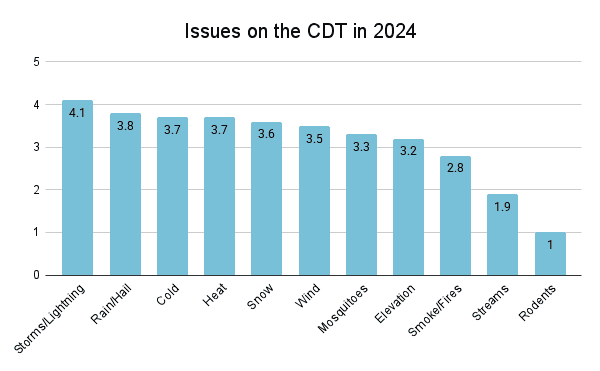
Why Hikers Didn’t Finish
If you were left wondering what happened to the hikers who didn’t complete the CDT this year when we covered the completion rates above, fear not. Here, we look at the specifics as to why hikers didn’t complete the Continental Divide Trail this year.
Why Thru-Hikers Quit
- 29.2% – Injury
- 16.7% – Personal
- 16.7% – Snow
- 8.3% – Family
- 4.2% – Boredom
- 4.2% – Financial
- 4.2% – Romance
- 4.2% – Stalker
- 4.2% – Trauma
- 4.2% – Weather
- 4.2% – Work
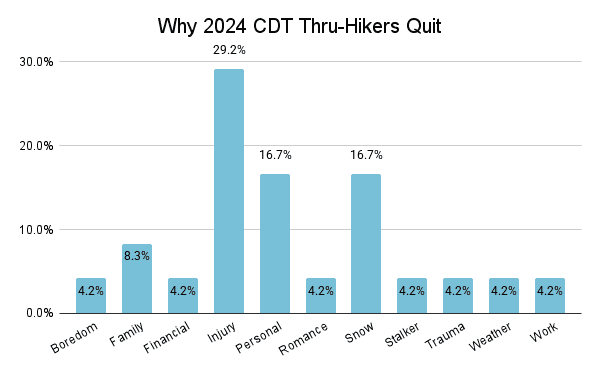
Hike-Ending Injury Breakdown
Injury is a big killer of thru-hikes and is typically something hikers can exercise some control over (as opposed to fires that can flare up seemingly without warning). Here, we break down what kinds of injuries ended hikes and where these hike-ending injuries occurred.
Hike-Ending Injuries
- 42.9% – Plantar fasciitis
- 28.6% – Overuse injury (leg)
- 14.3% – Broken ribs
- 14.3% – Stress fracture (leg)
Where Injuries Occurred
- 28.6% – New Mexico
- 14.3% – Colorado
- 57.1% – Wyoming
- 0% – Idaho/Southern Montana
- 0% – Northern Montana
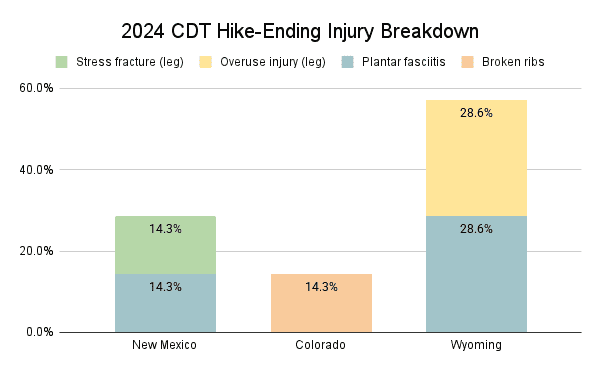
Miles Completed by Hikers
- 0% – < 100 mi
- 4.0% – 100 – 250 mi
- 0% – 250 – 500 mi
- 16.0% – 500 – 750 mi
- 12.0% – 750 – 1000 mi
- 0% – 1000 – 1250 mi
- 24.0% – 1250 – 1500 mi
- 8.0% – 1500 – 1750 mi
- 8.0% – 1750 – 2000 mi
- 16.0% – 2000 – 2250 mi
- 12.0% – 2250 – 2500 mi
- 0% – 2500 – 2750 mi
- 0% – > 2750 mi
Average: 1,460 mi / 2,350 km
Median: 1,500 mi / 2,414 km
σ = 632 mi / 1,017 km
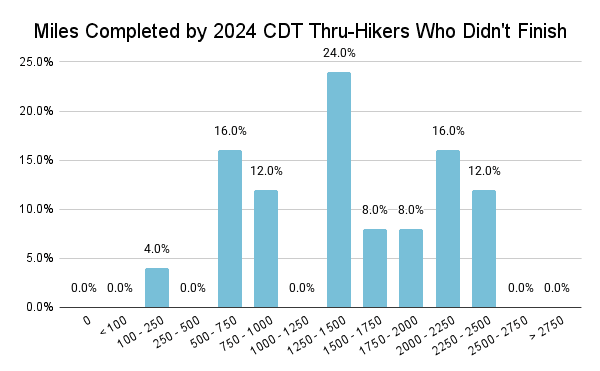
Resupply
The word resupply can be anxiety-inducing if you’re new to the idea of long-distance thru-hiking. What is resupply? Where does it come from? How much of it is there? How do you get it? Will it hurt?
Resupply is getting yourself more food to power more hiking. It need not be scary or intimidating. Continental Divide Trail resupply has become simpler over the years, but when and where hikers resupply is still a question that many find overwhelming.
Here we have this year’s resupply stats, resupply strategy/boxes, resupply box suggestions, hitchhiking difficulties, where hikers resupplied, favorite and least favorite resupply stops, favorite meals and snacks, and resupply advice.
CDT Resupply Stats
Thru-Hikers (1)
28
The average number of resupplies over the entire trail
(M = 28 | σ = 6.2)
Thru-Hikers (1)
6
The average number of days between resupplies
(M = 5 | σ = 1.8)
Thru-Hikers (1)
119
The average number of miles between resupplies (192 km)
(M = 109 mi / 175 km | σ = 39 mi / 63 km)
Thru-Hikers
4.0
The average number of resupply boxes prepared ahead of time
(M = 2 | σ = 5.6)
Thru-Hikers (1)
7
The average total number of resupply boxes sent
(M = 5 | σ = 5.2)
Thru-Hikers (1)
22%
The average percent of resupplies sent as boxes
(M = 11% | σ = 23%)
Resupply Strategy
- 1.6% – Mailed all resupply
- 8.2% – Mailed most resupply (> 50%)
- 40.2% – Mailed some resupplies (10-50%)
- 45.1% – Mailed a few resupply (1-10%)
- 4.9% – Mailed no resupply
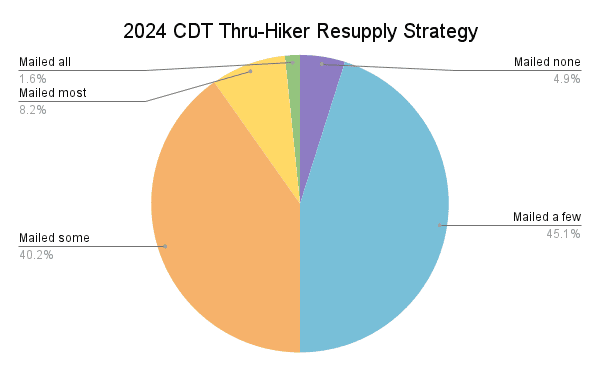
Many prospective CDT thru-hikers are incredibly concerned about resupply, but take a breath. Remember, you can mail yourself boxes from the trail. You do not have to prepare all your resupply boxes (or resupply locations) beforehand. Many towns have supermarkets (and post offices).
That said, it can be helpful (and time-saving) to mail yourself resupply boxes. Hikers may choose this option because of a resupply stop’s limited food selection, dietary restrictions, high prices, or even the owners of the local resupply establishment being awful people (that said, most are lovely).
Another thing to consider when considering resupply is that many towns along the CDT are only accessible via car (or ludicrously long, dangerous, and ill-advised road walks). How do you get to these towns? Many hikers elect to hitchhike.
Here are the places CDT hikers recommend sending a resupply box and where they had difficulty hitchhiking to/from.
Suggest Mailing Resupply
- Pie Town (New Mexico) 81.9%
- Ghost Ranch (New Mexico) 36.9%
- East Glacier Village (Northern Montana) 32.5%
- Lima (Idaho/Southern Montana) 32.5%
- Leadore via Bannock Pass (Idaho/Southern Montana) 30.6%
- Doc Campbell’s (New Mexico) 28.1%
- Benchmark Wilderness Ranch (Northern Montana) 21.3%
- Encampment via Battle Pass (Wyoming) 18.8%
- Old Faithful Village in Yellowstone (Wyoming) 18.8%
- Atlantic City (Wyoming) 8.1%
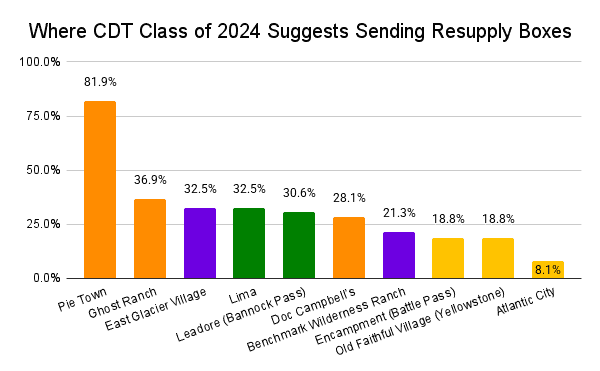
Difficult Hitches
- Chama via Cumbres Pass (New Mexico/Colorado) 21.1%
- Augusta (Northern Montana) 18.9%
- Leadore via Bannock Pass (Idaho/Southern Montana) 18.9%
- Encampment via Battle Pass (Wyoming) 14.4%
- Lander (Wyoming) 14.4%
- Lima (Idaho/Southern Montana) 14.4%
- Dubois via Togwotee Pass (Wyoming) 5.7%
- Lincoln (Idaho/Southern Montana) 10%
- Steamboat Springs via Rabbit Ears Pass (Colorado) 10%
- Pagosa Springs via Wolf Creek Pass (Colorado) 8.9%
These percentages are of the hikers who said they had difficulty hitchhiking to at least one location.
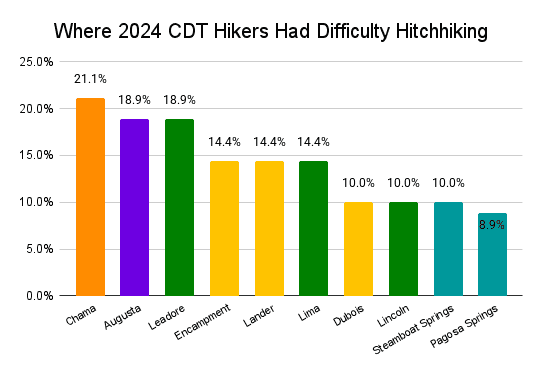
Note: 43.4% of thru-hikers (1) reported having no trouble hitchhiking.
Where Hikers Resupplied
I ask hikers to report where they resupplied – not where they stopped/passed through, but where they purchased, picked up, were given, or otherwise came into a new food stock. For example, the trail passes through the middle of Silver City; theoretically, all thru-hikers who complete the trail will go there, but not all thru-hikers resupply there. Make sense? I hope so. You’ll have issues on the trail if you’re struggling with this.
Locations are listed in geographical order from Mexico to Canada (south to north), and, again, I use the following colors to indicate each resupply stop’s popularity: over 75%, 50-75%, 25-50%, under 25%.
New Mexico Resupply
- Hachita – 3.2%
- ⛺ Lordsburg – 97.5%
- ⛺ Silver City – 96.2%
- ✉️⛺ Doc Campbell’s – 93.0%
- Reserve – 14.6%
- Davila Ranch – 4.4%
- ✉️⛺ Pie Town – 86.7%
- Quemado – 3.2%
- ⛺ Grants – 94.3%
- Albuquerque – 5.7%
- ⛺ Cuba – 95.6%
- Española – 0.6%
- Santa Fe – 12.7%
- Abiquiu – 12.7%%
- ✉️⛺ Ghost Ranch – 55.7%
- Taos – 0.6%
- Chama via Cumbres Pass – 92.4%
Colorado Resupply
- Pagosa Springs via Wolf Creek Pass – 77.9%
- South Fork via Wolf Creek Pass – 4.5%
- Platoro – 6.5%
- Del Norte – 7.8%
- Creede – 36.4%
- Silverton via Stony Pass – 14.9%
- Durango – 7.1%
- Lake City via Spring Creek Pass – 51.9%
- Sargents – 0.6%
- ⛺ Monarch Mountain Lodge – 8.4%
- Monarch Spur RV Park – 0.6%
- Salida via Monarch Pass – 87.7%
- Gunnison – 2.6%
- Poncha Springs – 0.6%
- Buena Vista – 26.6%
- ⛺ Twin Lakes – 60.4%
- Leadville – 68.2%
- ⛺ Copper Mountain – 11.0%
- Breckenridge – 38.3%
- Frisco – 29.9%
- Idaho Springs 0.6%
- Silverthorne – 27.3%
- Dillon – 10.4%
- Winter Park – 36.4%
- Fraser – 14.3%
- Denver – 10.4%
- ⛺ Grand Lake – 92.2%
- Steamboat Springs via Rabbit Ears Pass – 94.2%
Wyoming Resupply
- ✉️ Encampment via Battle Pass – 56.0%
- Riverside via Battle Pass – 12.0%
- ⛺ Rawlins – 98.2%
- ⛺ Big Sandy Lodge – 6.6%
- ⛺ South Pass City – 17.5%
- ✉️ Atlantic City – 10.8%
- Lander – 74.7%
- Pinedale – 61.4%
- Lava Mountain Lodge via Togwotee Pass – 2.4%
- Dubois via Togwotee Pass – 68.1%
- Togwotee Mountain Lodge – 0.6%
- Jackson – 22.3%
- ⛺ Brooks Lake Lodge – 7.2%
- Cody – 0.6%
- ⛺ Grant Village in Yellowstone – 34.3%
- ✉️⛺ Old Faithful Village in Yellowstone – 69.3%
- Mammoth Village in Yellowstone – 4.2%
- Flagg Ranch – 3.6%
Idaho/Montana Resupply
- West Yellowstone – 54.3%
- ⛺ Island Park / Mack’s Inn – 39.3%
- Big Sky – 10.0%
- Ennis – 7.1%
- ✉️ Lima – 82.1%
- ✉️ Leadore via Bannock Pass – 82.9%
- Tendoy – 0.7%
- Salmon – 8.6%
- Jackson – 5.7%
- Missoula – 5.0%
- Darby via Chief Joseph Pass – 68.6%
- Hamilton via Chief Joseph Pass – 5.7%
- Darby via Lost Trail Pass – 7.1%
- Hamilton via Lost Trail Pass – 1.4%
- Camp Sula – 3.6%
- Wisdom – 3.6%
- ⛺ Anaconda – 64.9%
- Whitehall – 10.1%
- Butte – 43.5%
- Bozeman – 11.9%
- Helena – 81.5%
- Elliston – 14.9%
- ✉️ Lincoln – 67.9%
- ⛺ Benchmark Wilderness Ranch – 22.6%
- ✉️ Augusta – 55.4%
- ⛺ East Glacier Village – 95.2%
- Browning – 3%
- ⛺ Two Medicine – 12.5%
- Saint Mary – 15.5%
- ⛺ Many Glacier – 25%
✉️ Stops where this year’s class suggests sending resupply boxes to
⛺ Stops that can be reached without hitchhiking (either on the trail or a relatively short detour)
Favorite & Least Favorite Resupply Stops
Now we know the most popular stops for resupplying and for sending resupply boxes, but what about hikers’ favorite and least favorite resupply stops? When asking this question, I specify, “‘Favorite/Least Favorite’ means where you most/least enjoyed, not where had the best/worst resupply options (although these could be the same).”
Favorite Resupply Stop
Silver City, NM
31% of hikers voted for Silver City
Least Favorite Resupply Stop
Lima, MT
32% of hikers voted for Lima
Favorite Resupply Stops
- New Mexico: Silver City (28%)
- Colorado: Leadville (25%)
- Wyoming: Lander (29%)
- Idaho/Montana: Anaconda (30%)
Runners-Up
- New Mexico: Doc Campbell’s (17%)
- Colorado: Salida (25%)
- Wyoming Pinedale (21%)
- Idaho/Montana: East Glacier Village (20%)
Least Favorite Resupply Stops
- New Mexico: Cuba (29%)
- Colorado: Grand Lake (8%)
- Wyoming Encampment (11%)
- Idaho/Montana: Lima (32%)
Runners-Up
- New Mexico: Pie Town (22%)
- Colorado: Steamboat Springs (7%)
- Wyoming Rawlins (8%)
- Idaho/Montana: Leadore (19%)
Hiker Diets
For the final piece of the resupply puzzle, we look at hiker dietary restrictions, how easily they found resupplying with them, and which backpacking meals and snacks hikers enjoyed most on the CDT. More on this is to come in the CDT Resupply Guide.
Dietary Restrictions
- 43.2% – Has dietary restriction
- 56.8% – No dietary restriction

Specific Dietary Restrictions
- 34.6% – Vegetarian
- 25.0% – Vegan
- 19.2% – Beef-free
- 15.4% – Pescatarian
- 13.5% – Dairy-free
- 9.6% – Gluten-free
- 9.6% – Lactose intolerance
- 9.6% – Lactose-free
- 3.8% – Kosher
- 3.8% – Tree-nut allergy
- 1.9% – Peanut allergy
- 3.8% – Other
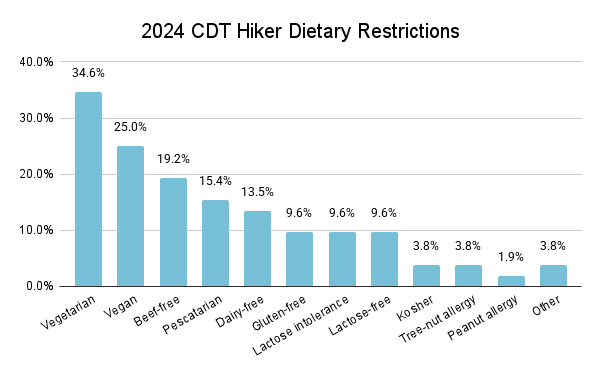
Note: These percentages are of the hikers who reported a dietary restriction.
Favorite Backpacking Meals
- Ramen 35.5%
- Knorr Rice Sides 31%
- Peak Refuel 28.4%
- Idohoan Mashed Potatoes 23.2%
- Couscous 20%
- Mountain House 17.4%
- Annie’s Mac & Cheese 15.5%
- Backpacker’s Pantry 13.5%
- Good To-Go 11%
- Mac & Cheese (not Annie’s) 9.7%
Favorite Backpacking Snacks
- Cheese 29.6%
- M&M’s 25.1%
- Dried Fruit 24%
- Peanut Butter 20.1%
- Snickers Bars 19%
- Potato Chips 18.4%
- Bobo’s Oat Bars 16.8%
- Fritos 16.8%
- Sour Patch Kids 16.8%
- Sour Gummy Worms 16.2%
Resupply Changes
Hindsight is 20/20 (unless you’re looking back through the darkness for that mountain lion you think might be following you – but that’s likely a deer). Here is what hikers said they would change about their resupply strategies if they could do it again.
These don’t change much yearly, so I highly encourage you to heed this advice when considering your resupply options.
36.4% of hikers say they would have changed their resupply strategy. Here are the most popular changes hikers would have made to their CDT resupply. Percentages are of hikers who said they would change something about their resupply.
- Send fewer resupply boxes* (32.5%)
- Send more resupply boxes** (23.4%)
- Send healthier food in boxes (19.5%)
- Send more variety in boxes (16.9%)
- Send boxes from on the trail instead of ahead of time (11.7%)
- Send less food in boxes (9.1%)
*The average number of boxes sent by hikers who said they would have liked to have sent fewer boxes was 6.9.
**The average number of boxes sent by hikers who said they would have liked to have sent more boxes was 6.2.
Thru-Hikers
21.3%
The number of thru-hikers who went stoveless for the entirety of their hikes.
I’ll follow up with a detailed breakdown of this year’s CDT resupply. If you would like to be notified of new posts, click here.
Find all CDT Resupply posts here.
Thru-Hiking Gear
Potentially, what Continental Divide Trail hikers spend the most time obsessing over before (and on…and after) the trail is their thru-hiking gear. Gear choices play an essential role in a thru-hike, but no magical gear combination guarantees a successful thru-hike (if you know otherwise, please let me know).
I do a deep dive into gear used by CDT hikers in my CDT Gear Guide, but here’s a taste of what to expect. Let’s look at what this year’s CDT Class had with them on the trail.
Thru-Hikers
15.49 lb
Average pre-hike base weight (7.026 kg)
(M = 15 lb / 6.8 kg | σ = 6.05 lb / 2.74 kg)
Thru-Hikers (1)
14.61 lb
Average post-hike base weight (6.626 kg)
(M = 14 lb / 6.35 kg | σ = 5.75 lb / 2.6 kg)
Thru-Hikers (1)
-0.64 lb
Average total change in base weight (290 g)
(M = 0)
Thru-Hikers
50.8 L
Average backpack size
(M = 55)
Thru-Hikers
17°F
Average sleeping bag rating (-8.3°C)
(M = 20°F / –6.7°C)
Thru-Hikers (1)
4.9
Average total number of shoes used
(M = 5)
More detailed and interesting breakdowns of this information are in this year’s CDT Gear Guide. Let’s peek at some of the gear thru-hikers were using on the trail this year. Here are the most common “Big 4” items: packs, shelters, sleeping bags/quilts, and sleeping pads (I know it’s the “Big 3”, but I include sleeping pads; get over it) along with the most common insulated jackets and shells.
Again, there will be extensive breakdowns in the CDT Gear Guide.
Most Common CDT Backpacks
Most Common CDT Shelters
Most Common CDT Sleeping Bags/Quilts
Most Common CDT Sleeping Pads
- Therm-a-Rest NeoAir XLite NXT
- Therm-a-Rest NeoAir XTherm NXT
- Therm-a-Rest NeoAir XLite – Women’s (discontinued)
- Therm-a-Rest NeoAir XLite NXT, Short
- NEMO Tensor Trail
- Therm-a-Rest Z Lite Sol
- Big Agnes Rapide SL
- NEMO Switchback
- NEMO Tensor All Season Ultralight
Most Common CDT Insulated Jackets
- Enlightened Equipment Torrid (Men’s/Women’s)
- Mountain Hardwear Ghost Whisperer/2 Hoody (Men’s/Women’s)
- Decathlon Forclaz MT100 Hooded (Men’s/Women’s)
- Patagonia Micro Puff Hoody (Men’s/Women’s)
- Mountain Hardwear Ghost Whisperer/2 (Men’s/Women’s)
- Feathered Friends Eos (Men’s/Women’s)
- Montbell Superior Jacket (Men’s/Women’s)
- Arc’teryx Cerium Hoody (Men’s/Women’s)
- Patagonia Micro Puff (Men’s/Women’s)
- Patagonia Nano Puff Hoody (Men’s/Women’s)
Most Common CDT Shells
- Frogg Toggs Ultra-Lite Rain Suit (Men’s/Women’s)
- Outdoor Research Helium (Men’s/Women’s)
- Montbell Versalite (Men’s/Women’s)
- Enlightened Equipment Visp (Men’s/Women’s)
- Lightheart Gear Rain Jacket
- Zpacks Vertice (Men’s/Women’s)
- Patagonia Torrentshell (Men’s/Women’s)
- Black Diamond StormLine Stretch (Men’s/Women’s)
- Marmot PreCip Eco (Men’s/Women’s)
- REI Co-op Trailmade (Men’s/Women’s)
This is just the tip of the proverbial thru-hiking gear iceberg. As mentioned above, I will publish a detailed breakdown of this year’s CDT gear. This will include (in addition to everything above) water treatment, stoves, fleeces, snow gear, satellite messengers/PLBs, additional gear, luxury items, what hikers didn’t like about their gear, what gear decisions (might have) helped hikers to a successful thru-hike, how hikers would change/adapt their gear for a future hike, and more.
Technology on Trail
Gone are the days of the Continental Divide Trail of old when it was a trail sought out by only uber-experienced backcountry orienteers; thanks to the magic of technology, any dodo can grab a phone and have a reasonably good chance of not killing themselves on the trail.
Phones are everywhere on the trail. If the sight of a cellular device in the wilderness distresses you, prepare yourself. Phones are hikers’ cameras, GPS devices, televisions, music players, town-researching devices, and (sometimes) SOS devices (that said, I suggest a Garmin inReach Mini 2 if you’re looking for an SOS device).
There are several apps commonly used by Continental Divide Trail hikers – one designed specifically for the CDT (that you should most certainly invest in). Here are the phones and apps hikers were using out on the trail this year.
CDT Hiker Phones
- 41.3% – Android
- 58.2% – iOS (iPhone)
- 0.5% – Didn’t carry a phone
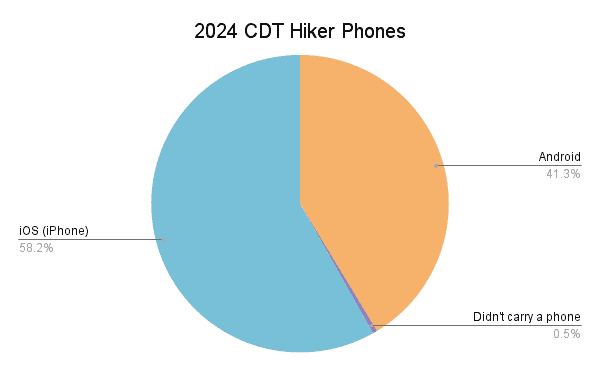
CDT Hiker Apps
- 98% – FarOut Guides
- 60.4% – Gaia GPS
- 47% – Google Maps
- 29.7% – Avenza Maps
- 19.8% – Garmin Explore
- 13.4% – CalTopo
- 8.9% – AllTrails
- 8.9% – Peak Finder
- 7.9% – Strava
- 6.4% – onX Backcountry
- 5% – Merlin
- 3.5% – Colorado Trail Explorer (COTREX)
- 3.5% – Seek by iNaturalist
- 2% – Locus Maps
- 1.5% – Hiking Project

Hiker Health & Water Sources
Water treatment and personal hygiene are (or should be) big considerations for hikers. Typically, thru-hikers worry less about these as the trail goes on; experience isn’t always your friend.
Some hikers religiously filter all water that passes through their face hole – it doesn’t matter if it comes out of a hotel sink or a puddle with a cow pooping in it. Other hikers will “not filter above 10,000 ft / 3,048 m” or “not filter running water” (this last one is not a good idea – running water can 100% get you sick).
Everyone wants to look cool in front of their friends by not filtering water (note: not filtering your water does not make you cool), but there are risks to the badass thru-hiker lifestyle (and drinking dirty, giardia-infested water).
To find out how good a job everyone is doing filtering their water and sanitizing their hands after pooping (another way to get yourself sick), I ask hikers if they got sick (defined as 3+ days of digestive issues or diagnosed giardia), how often they treated water sources, and how these two things compare to one another.
CDT Hiker Illness
- 96.2% – Didn’t get sick
- 3.8% – Got sick
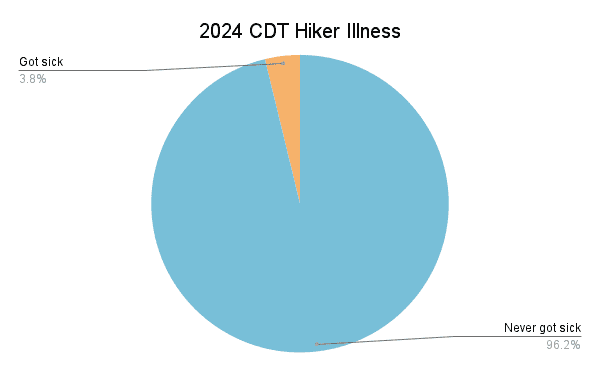
Water Treatment Frequency
- 71.1% – Always
- 22.3% – Usually
- 6.6% – Sometimes
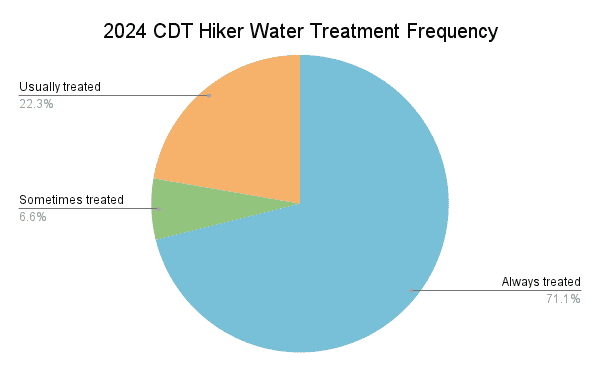
Looking at this another way, we can see the following.
- 71.1% of hikers always treated their water, and 2.7% of these hikers got sick
- 22.3% of hikers usually treated their water, and 3.8% of these hikers got sick
- 6.6% of hikers sometimes treated their water, and 14.3% of these hikers got sick
- 0% of hikers never treated their water
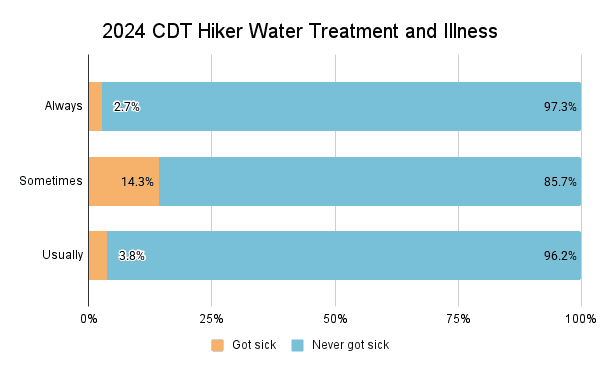
A reported 3.8% of hikers came down with something akin to giardia, and 0% never filtered.
Favorite/Least Favorite Sections
This may come as a shock, but the Continental Divide Trail is a long hike with a lot to see (mostly bears). Here is a look at the favorite and least favorite sections of the trail.
Favorite CDT Section
- Wyoming
- Colorado
- Northern Montana
- New Mexico
- Idaho/Southern Montana
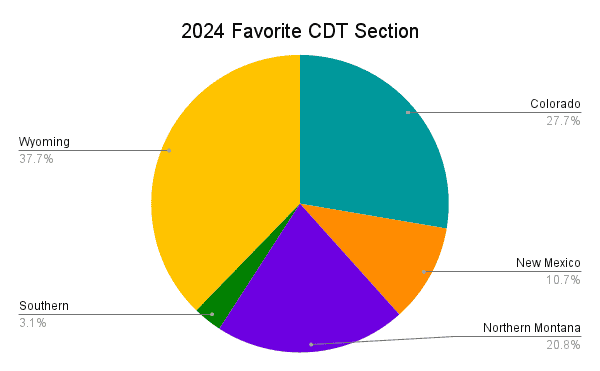
Least Favorite CDT Section
- Idaho/Southern Montana
- New Mexico
- Colorado
- Northern Montana
- Wyoming
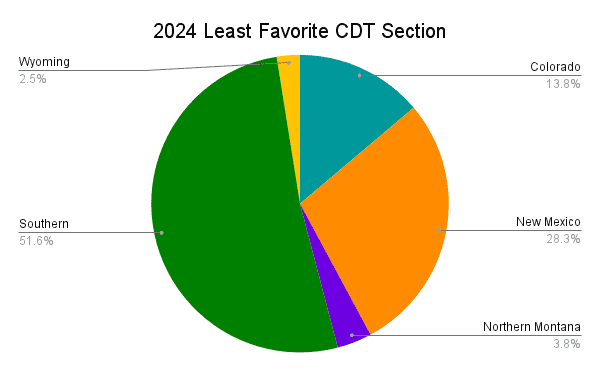
Favorite Section
Wind River Range
Wyoming (89%)
Least Favorite Section
Pie Town to Grants
New Mexico (62%)
Favorites
- New Mexico: Gila River Alternate (81%)
- Colorado: San Juan Mountains (54%)
- Wyoming: Wind River Range (89%)
- Idaho/Montana: Glacier National Park (81%)
Least Favorites
- New Mexico: Pie Town to Grants (62%)
- Colorado: Rocky Mountain National Park (13%)
- Wyoming: Great Divide Basin (35%)
- Idaho/Montana: Idaho/Montana Border (34%)
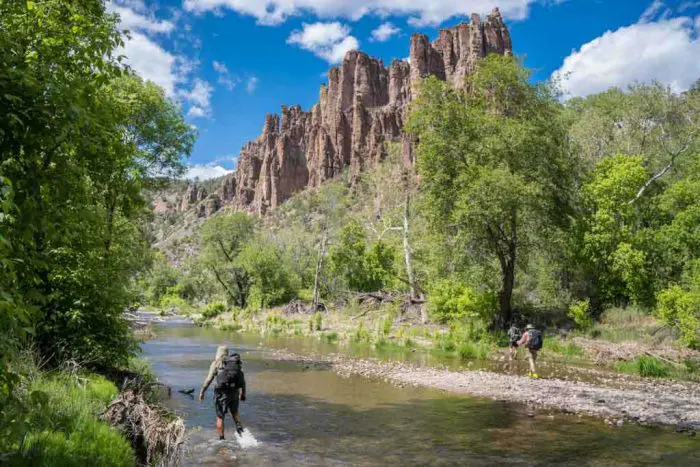
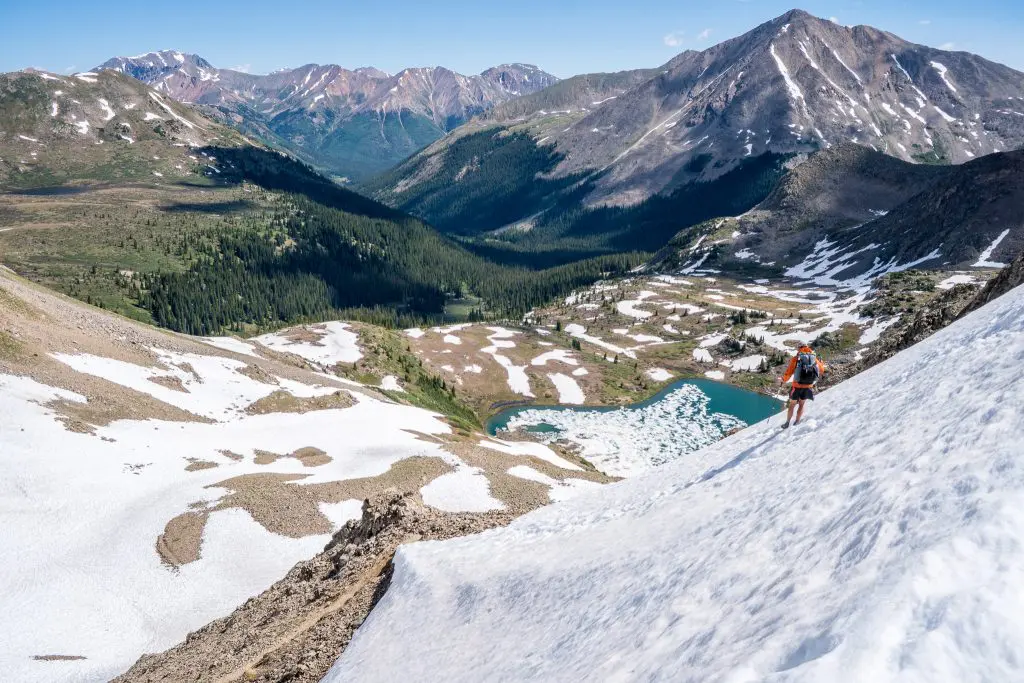
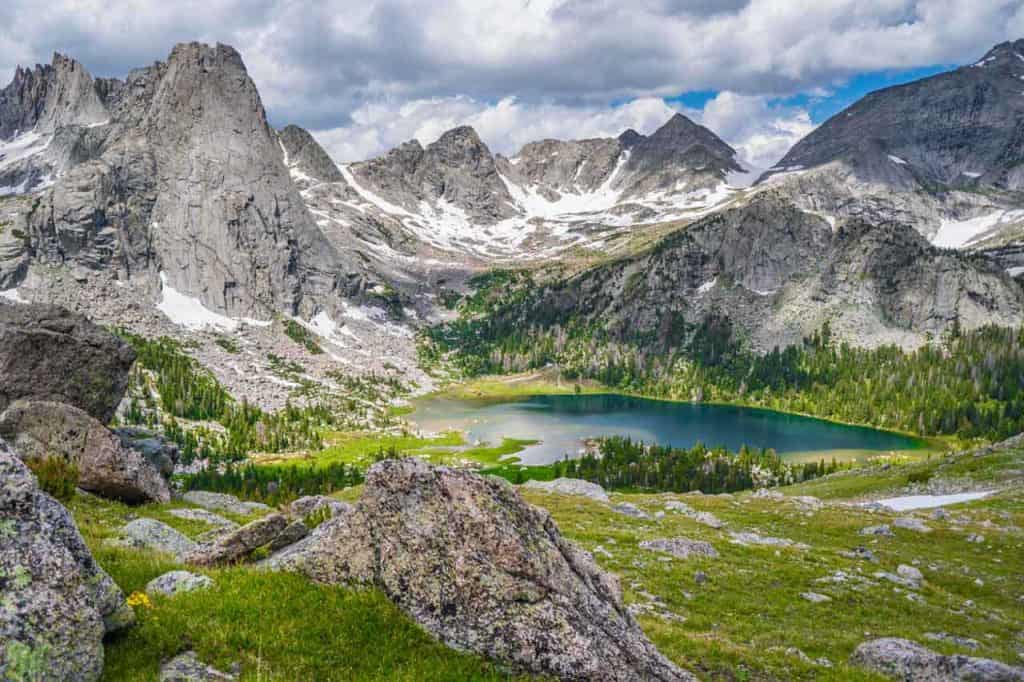
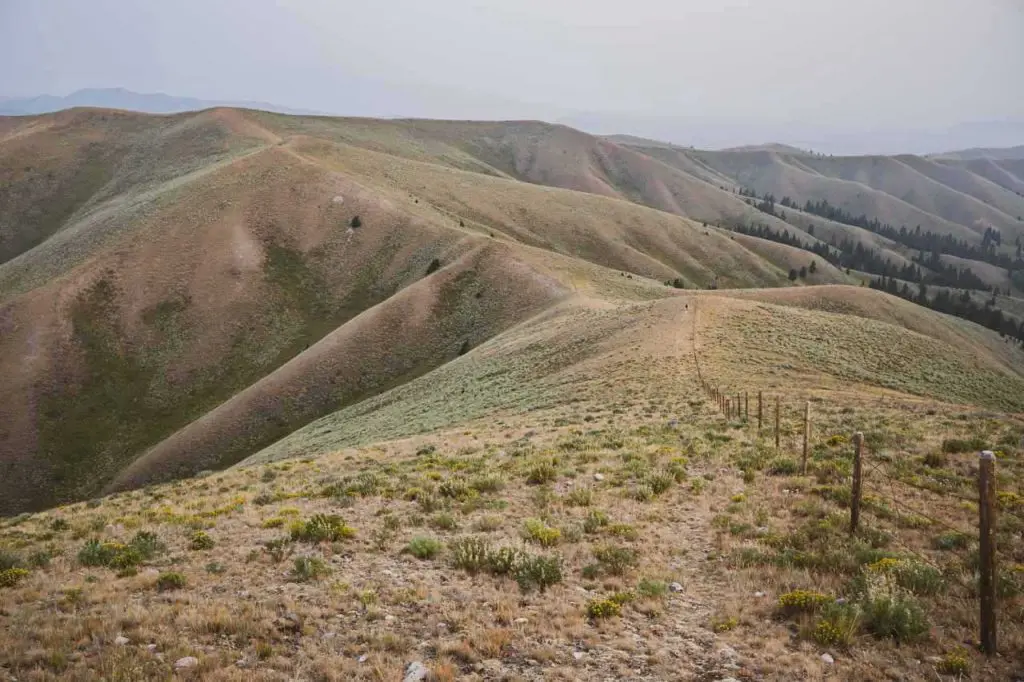
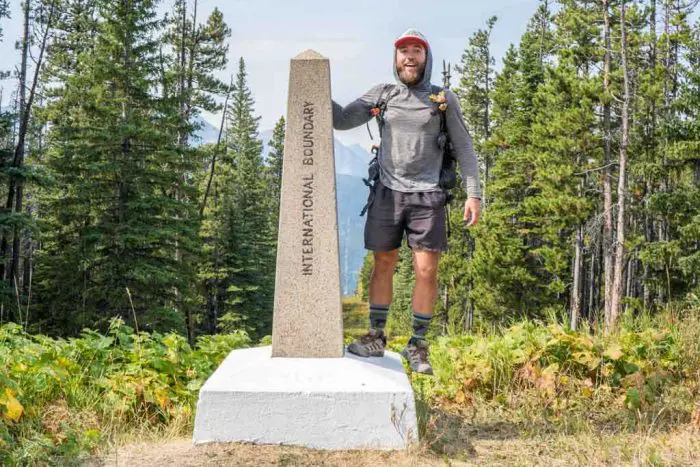
Best & Worst Moments
I will share more of these in future posts, but here are some examples that stood out when I asked hikers about their best, worst, and most terrifying moments from their thru-hikes.
Best CDT Moments
- Hanging out at the Toaster House feeding the fire, eating free pie with some cyclists while a snowstorm dumped outside.
- SOBO trail days in Leadville was an incredible reunion with many people I hadn’t seen in weeks, and we had an awesome party. Parts of the trail were undoubtedly better, but the two days I spent in Leadville got me back into a good headspace that allowed me to finish the trail instead of getting off at the end of Colorado like I was planning.
- When hitching into Darby, we were picked up by the friendliest man! He treated us to the most incredible trail magic for a whole morning! He bought us coffee, gave us lots of bars, offered a ride back, and wanted to give us all the money we needed (we didn’t accept it).
Worst CDT Moments
- Between Breckenridge and Denver. I had to bail out once and chose day hikes/slackpacking to get me through. The weather was unfavorable due to high winds, rain/hail, low visibility, and sheer cold, which made me scared/unable to last at unexposed high altitudes. I questioned if I could even make it. I had a friend help me piece together lower-elevation day hikes until a better weather window allowed me to get the high-elevation section in before moving north.
- I know everyone hates rain, but there was a stretch in northern CO around Grand Lake where it felt like it rained EVERY evening and morning, which meant setting up and taking down camp soaking wet. I was begging to be in the hot, dry basin. It might’ve been the Bob if I hadn’t been with friends. Don’t Bob alone!
- Every damn day. This trail is an ass-kicker. But probably the worst was seeing the headlights of a ride I needed, full-tilt running several miles to the trailhead, and just missing them. Staring at their retreating far-away taillights in the dark, knowing no other car was coming. Or, almost falling off a 2000 ft / 610 m slope because the mashed potato snow mushed into the loose gravel and made it a slide. Or not sleeping for weeks because of the body-covering fly bites. Others too. Hard to pick just one.
Scariest CDT Moments
- Hypothermia with nowhere to set up and get dry.
- There were a few storms that scared me. Especially being on a ridge when lightning storms roll through. I had my tent collapse a few times during the worst ones.
- A weird, crazy man was screaming and driving around in the woods on some motorcycle between Anaconda and Helena. It freaked us out, so we moved our tent in the middle of the night so he would not see us from the road.
The Continental Divide Trail is, for the most part, an amazing place filled with incredible people.
However, just as the trail can be not so excellent at times – thunderstorms, fires, horrific weather events – the people, too, can occasionally be awful on the CDT.
There will be an additional article covering social issues on the trail in more detail.
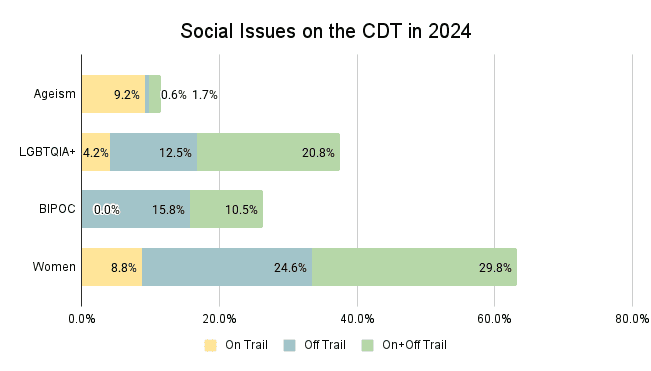
Ageism
Overall, 11.5% of hikers experienced ageism on the Continental Divide Trail. 9.2% experienced ageism (only) from other hikers, 0.6% from people in town, and 1.7% from fellow hikers and people in town.
As hikers of various ages reported ageism, these percentages are for all hikers.
Homophobia/Transphobia
Overall, 37.5% of LGBTQIA+ hikers experienced homophobia or transphobia on the CDT. 4.2% experienced homophobia or transphobia (only) from other hikers, 12.5% from people in town, and 20.8% from fellow hikers and people in town.
Racism
Overall, 26.3% of BIPOC hikers experienced racism on the CDT. 0% experienced racism from (only) other hikers, 15.8% experienced racism from people in town, and 10.5% from fellow hikers and people in town.
Sexism
Overall, 63.2% of female hikers experienced sexism or sexual harassment on the CDT. 8.8% experienced sexism (only) from other hikers, 24.6% from people in town, and 29.8% from both their fellow hikers and people in town.
Trail Magic
Trail angels can be a tricky bunch. Sadly, there are trail angels who are likely responsible for some of the behavior in the above section. However, many (I would hope most) trail angels are well-meaning folks out to help hikers.
I asked hikers about the frequency with which they encountered or received trail magic. This could mean a friendly person on the trail sharing some fresh fruit with them or a trail angel hanging out at a trailhead giving cold drinks and rides to hikers.
Hikers reported, for each section, how often they encountered trail magic on a scale of 1 (never) to 10 (every day).
- 2.8 – New Mexico
- 2.2 – Colorado
- 1.7 – Wyoming
- 1.4 – Idaho/Southern Montana
- 1.7 – Northern Montana
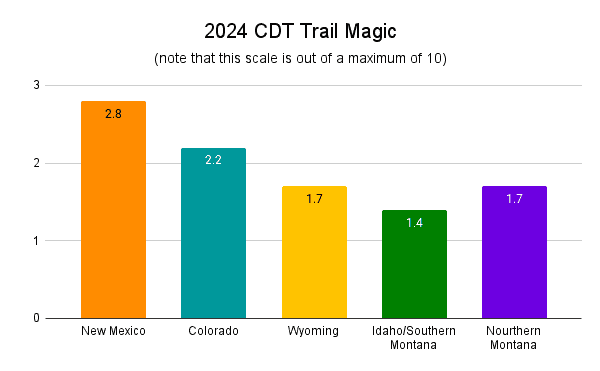
Advice for the Future
Now for Continental Divide Trail thru-hiker wisdom. I ask hikers what they would have done differently before their hikes if they were to do it all over again.
Pre-Hike Changes
64.6% of thru-hikers said they would have changed something before beginning their hikes. Here are the most common changes from those who said they would change something.
- Trained more/gotten in better shape (33.6%)
- Gotten base weight down/bought lighter gear (30.3%)
- Saved more money (27.9%)
- Started later (17.2%)
- Had gear more dialed in (13.9%)
- Planned less (10.7%)
- Planned more (9%)
- Started earlier (9%)
- Done more practice hikes (8.2%)
Thru-Hikers
19.74 lb
The average base weight of hikers who said they would have liked to have gotten lighter gear before starting their hikes (8.954 kg)
In addition to asking hikers what they would have done differently before their thru-hikes, I asked them what they wished they had done differently during their hikes. Here are the top responses (regrets).
During Hike Changes
73.5% of thru-hikers said they would have changed something during their hikes. Here are the most common changes from those who said they would change something.
- More pictures of people (61.2%)
- Slowed down (20.9%)
- Maintained a journal/blog (18%)
- Fewer zero days (17.3%)
- Less time in town (13.7%)
- Sped up (10.8%)
- More trail zeros (8.6%)
- More time in town (5%)
- More zero days (4.3%)
Thru-Hikers (1)
21
The average number of zero days taken by hikers who said they wish they had taken fewer during their thru-hikes
Thru-hiker Advice
I ask hikers what advice for future CDT hikers they have. This will be thoroughly documented in the upcoming post, CDT: Advice For The Future; here is a sample.
- Embrace night hiking in the desert and the Basin and taking long siestas during the hottest part of the day. I knew of several people getting heat stroke from just trying to grind through the heat and getting dehydrated. Plus, hiking under the stars is incredible.
- Save at least 25% more money than you think you will need. Flipping is more common than you think, and it’s not cheap. Plus, in general, everything is more expensive now. That 25% more will give you a nice buffer if something happens.
- I would not recommend this trail to folks who haven’t thru-hiked before. If your favorite part about thru-hiking the Appalachian Trail or Pacific Crest Trail was the social aspect of trail life, this trail probably isn’t for you.
Animal Sightings
Some data that doesn’t quite fit anywhere else? What kind of wildlife did Continental Divide Trail hikers see on the trail? The most common animals? Deer. The worst. The rarest of the animal kingdom? Gila monster (yes, it’s a real animal – an awesome venomous reptile, look it up).
I would wager that some percentage of the 16.1% who reported seeing a mountain lion saw some eyes in the dark that were probably (most certainly) not a mountain lion. Just saying. I’m probably just jealous because the only time I’ve seen one and it was from a car.
Note that these percentages are from thru-hikers (1).
- 99% – Deer
- 98% – Elk
- 97% – Moose
- 96% – Marmot
- 93% – Pika
- 91% – Mountain goat
- 89% – Snake (not rattler)
- 84% – Black bear
- 81% – Fox
- 80% – Mustang
- 80% – Pronghorn
- 71% – Rattlesnake
- 69% – Coyote
- 63% – Owl
- 57% – Grizzly bear
- 50% – Bison
- 46% – Porcupine
- 40% – Pine marten
- 24% – Badger
- 22% – Skunk
- 16% – Mountain lion
- 12% – Bobcat
- 12% – Wolf
- 11% – Tortoise
- 5% – Gila monster

Support the Survey
Every year, I receive numerous requests for guidance on how to support the surveys. Beyond sharing them with your close-knit bubble of weird hiker friends, the best way to support the survey is to contribute via Patreon. You’ll get access to exclusive posts, discount codes, live streams, and super awesome stickers so that everyone will know how cool you are.
If you’re not into Patreon, that’s cool; you can Venmo @halfwayanywhere, Cash app $halfwayanywhere, or PayPal moc.erehwynayawflah@tcatnoc
This is not expected. The data collected in the survey will always be free and accessible to everyone who wants/needs it. Your support is much appreciated and helps pay the website (and survey) bills.



CDT Survey Collection
Finally, another HUGE THANK YOU to all the hikers who completed this year’s survey, including (but not limited to): Ace, Achilles, All Day, Alligator, Always, Aqua, Arrow, Aster, Barefoot, Batona, Bearspray, Beaver, Beerman, Bestchance, Big Catt, Big Heart, Big Iron, Blouse, Blumpkin, Boat, Bob, Bookworm, Buck50, Busdriver, C7, Cactus, Camel, Canyon, Captain, Captain Caveman, Cast Iron, Catmando, Chance, Chefrey Bezos, Chip, Clip, Cocoa Bean, Collector, Cookie, Crumbs, Crunchy, Cuppa, D20, Dave, Deuces, Dirty Bird, Dish Dadd, Double Dip, Dozer, Dr. Zoom, Druide, Ducttape, Dutch Tin Man, Early Bird, Egg, Extra, Fancy Feast, Firecracker, Flood, G-Money Cancun, GG, Ghost, Giggles, Good Vibes, Grapenut, Half & Half, Hamilton, Highrise, Hot Wheels, Hotpocket, Hunter, Iceman, Icyhot, Inspector, Jet, Jobie, Journey, JR, Kaboom, Kaput, Knee Deep, Link, Little Legs, Logan, Lookout, Lost And Found, Lt. Dan, Lumberjack, Macgyver, Medic, Metrick [One-Red-Shoe], Mexican Lip Balm, Miner, Miss, Mitten, MonkeyMan MM, Mosey, Mountain Goat, Mr Tree, Mr. Clean, Muddie, Mugwort, Mulligan, Narrator, Navigator, Niccolo, Nobody, Owl, Oz, Pathfinder, Peanut Gallery, Piñata, Piper, Pole, Poppins, Purple Haze, Quickmunch, Rabbit, Rainman, Raptor, Ravenclaw, Ready, Recharge, Ribbit, Robot, Rock Slide, Rocket, Rocksteady, Saint, Salt, Salt Lick, Sam The Kid, Savedit, Semper Dry, Seventy, Shorty, Shotput, Shovel, Side Quest, Six2, Skeeter, Skip, Slay!, Snack Hole, Sniper!, Snooze, Speedy, Speedy Pinecone, Spinaltap, Spirit, Spirit Kick, Stargate, Stoat, Stove, Strangelove, Sunny Side Up, Sunrise, Super Chill, Swisscake, Syrup, The Best Daughter, The Chairman, The Dentist, Tin Manfl, Toby, Toe, Triple T, Trouble, Tweety, Two Braids, Two Dog, V, Viking, Waltzing Matilda, Whatever, Wizard, Works Hard, Young Energy, and Zero-Suck.
If you have any feedback, comments, or suggestions to improve the survey or data you would like to see in future posts or surveys, let me know!
Affiliate Disclosure: This page may contain affiliate links, which means I may receive small commissions for purchases made via these links at no additional cost to you. This helps pay the bills and keep the site up and running. Thank you for your support!
o
c
C
a
m
p
b
e
l
l
‘
s



